Chinese Architecture
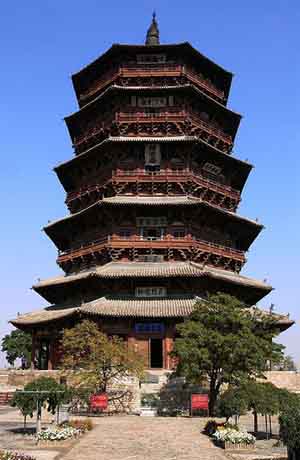
Chinese architecture refers to a style of architecture that has taken shape in Asia over many centuries. The structural principles of Chinese architecture have remained largely unchanged, the main changes being only the decorative details. Since the Tang Dynasty, Chinese architecture has had a major influence on the architectural styles of Korea, Vietnam and Japan.
The architecture of China is as old as Chinese civilization. From every source of information - literary, graphic, exemplary - there is strong evidence testifying to the fact that the Chinese have always employed an indigenous system of construction that has retained its principal characteristics from prehistoric times to the present day. Over the vast area from Chinese Turkistan to Japan, from Manchuria to the northern half of French Indochina, the same system of construction is prevalent; and this was the area of Chinese cultural influence. That this system of construction could perpetuate itself for more than four thousand years over such a vast territory and still remain a living architecture, retaining its principal characteristics in spite of repeated foreign invasions - military, intellectual, and spiritual - is a phenomenon comparable only to the continuity of the civilization of which it is an integral part.
The following article gives a cursory explanation of traditional Chinese architecture, before the introduction of Western building methods during the early 20th century. Throughout the 20th Century, however, Western-trained Chinese architects have attempted to combine traditional Chinese designs into modern (usually government) buildings, with only limited success.
Moreover, the pressure for urban development throughout contemporary China required
higher speed of construction and higher floor area ratio, which means that in the great cities the demand for traditional Chinese buildings, which are normally less than 3 levels, has declined in favor of modern architecture. However, the traditional skills of Chinese architecture, including major carpentry, minor carpentry, masonry, and stone masonry, are still applied to the construction of vernacular architecture in the vast rural area in China.
Bilateral symmetry and the articulation of buildings are found everywhere in Chinese architecture, from palace complexes to humble farmhouses. When possible, plans for renovation and extension of a house will often try to maintain this symmetry provided that there is enough capital to do so.
In contrast to the buildings, Chinese gardens are a notable exception which tends to be asymmetrical. The principle underlying the garden's composition is to create enduring flow
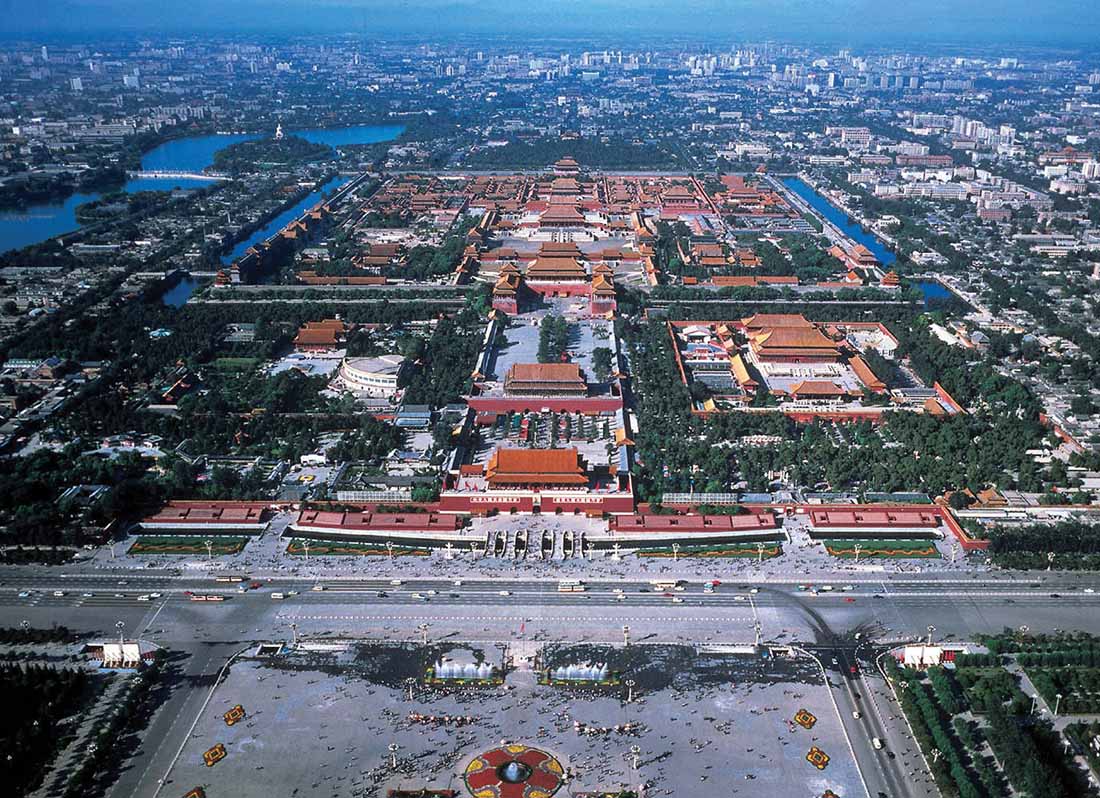 |
| Forbidden City |
The history of science and technology in China is both long and rich with many contributions to science and technology. In antiquity, independently of Greek philosophers and other civilizations, ancient Chinese philosophers made significant advances in science, technology, mathematics, and astronomy. The first recorded observations of comets, solar eclipses, and supernovae were made in China. Traditional Chinese medicine, acupuncture and herbal medicine were also practiced.
Among the earliest inventions were the abacus, the "shadow clock," and the first flying machines such as kites and Kongming lanterns. The four Great Inventions of ancient China:
the compass, gunpowder, papermaking, and printing, were among the most important technological advances, only known in Europe by the end of the Middle Ages. The Tang Dynasty (AD 618 - 906) in particular, was a time of great innovation. A good deal of exchange occurred between Western and Chinese discoveries up to the Qing Dynasty.
The Jesuit China missions of the 16th and 17th centuries introduced Western science and astronomy, then undergoing its own revolution, to China, and knowledge of Chinese technology was brought to Europe. Much of the early Western work in the history of science in China was done by Joseph Needham.
History of science and technology in China
Inventions from China include:
Alchemy Alchemy was Taoist chemistry, very different from modern chemistry.
Anesthetic - third century found a wine that acted like anesthetic, and they also used herbs before the age of written history
Astronomy - Planetarium - They produced the first planetarium, which was actually made by an emperor. The planetarium was a big enclosed place with stars and constellations on the inside. The person using the planetarium would sit in a chair that was hanging from the top of the enclosed dome.
Astrology - Chinese astrology and constellations were often used for divination
Bamboo - They made most toys, machines, houses, and other things from bamboo.
Blast Furnace - which was water powered
Block Printmaking / Printing Technology
Clocks - The first clock that they devised was for astronomical uses. In the first clock ever, there was a puppet that would hold up a plaque that would tell the time. They also invented giant water clocks, which rang every fifteen minutes.

Compass - was for religious use. When a new houses was being built, the used it to see if the house was faced in perfect harmony with nature (which meant they thought if you faced your house to magnetic north, you and nature would get along). The compass started out as a wooden circle with markings on it, and a magnetic spoon on top.
Crossbow
Earthquakes - Designed with a machine called the Earthquake weathercock, which was a contraption that told them when and where an earthquake would come. This machine looked like a giant six-foot bronze pot that had dragon heads lining the top, and ivory frogs under each dragon.
Fan - which was mostly carried by women and soldiers. Most of the fans were made out of bamboo and silk. The fan was basically many bamboo spines sticking out in almost a half circle with silk wrapped around it.
Fireworks - invented in the T'ang dynasty. These were originally for shows, but later on they used them to scare of enemies in war. The fireworks were mainly small bamboo cases filled with gunpowder, and a fuse was put on the side.
Glider
Harness - revolutionized agriculture by harnessing animals
Hot Air Balloon
Iron casting around the sixth century, when they mixed tin and copper together.
Kites - which mostly children played with. The kites were most of the time silk squares, held together by bamboo. Created many things with bamboo, which made a lot of baskets and holders and were really strong.
Lacquer
Mathematics - They invented the Asian Abacus. The main applications of mathematics in traditional China were architecture and geography. Pi was calculated by 5th century mathematician Zu Chongzhi to the seventh digit. The decimal system was used in China as early as 14 Century BC. "Pascal's" Triangle was discovered by mathematician Liu Ju-Hsieh, long before Pascal was born.
Military Inventions
Military innovations include the crossbow and the grid sight, crossbow stirrup, repeating crossbows, poison gas (smoke from burning dried mustard), tear gas made from powdered lime, relief maps for battle planning, manned kites, fire lance, rockets, gunpowder incendiaries, gunpowder grenades, proto-handguns, various gun-related ammunition types and the cannon.
Gunpowder - In the T'ang dynasty gunpowder was accidentally invented in an attempt to make the elixir of life, to make the emperor immortal. Cannon - were just bamboo cases holding gunpowder and were put in a big iron cannon. Bamboo or iron basket, which was like a smaller version of the cannon, that had arrows with rockets attached to them. The arrow rockets would shoot out of the miniature cannon like bullets out of a gun wood.
The nest cart was a mobile lookout, for oncoming armies and other things. The people in the nest cart also dropped bombs from their perch, which was perfect because they had a bird's eye view.
The first to make bombs for war, in the 17th Century, which were no more then a bamboo shell, about the thickness of two men's legs, and the length of a man's leg. The bombs were then filled with gunpowder, and a fuse like the fireworks, was installed.
Paper [See Below]
Porcelain
Rudder
Seismograph
Silk - first harvest silk, and make clothes, fans, kites, toys, paper, and lots of other things from it.
Spaghetti
Stirrup
Wheelbarrow - Invented in the Han dynasty and used for carrying loads too heavy for a normal person's back to support. The wheelbarrow was originally wood, so the Chinese nick named it the 'wooden ox'.
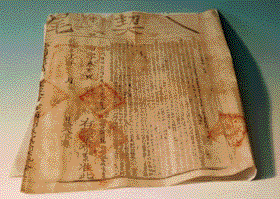

Ancient Chinese were the first to invent paper and printing. Their early script contained 80,000 different characters.
They went on to invent books and had book shops in every city by the end of the T'ang dynasty.
There were 3 different important kinds of paper, the very first being silk rags. The cheap kinds were no more the wooden strips, and the most expensive was silk cloth. Although most of the kinds of paper was made from over 50%bamboo, some of the other things they were made of were silk, cloth, hemp, mulberry bark, and plant fibers.
In the Han dynasty, 206B.C.-A.D.220, paper and ink were invented.
In the T'ang dynasty, 618-906, the first printer was invented. In 868 AD the earliest known book ever was printed.
About 1,800 years ago, during the Eastern Han Dynasty (25-220), Cai Lun improved China's papermaking technique using bark and hemp. This then became one of the four great ancient inventions of Chin. Today, ancient papermaking has been replaced by modern means of production, but in some places in southwestern China's Guizhou Province, where many people of ethnic-minority groups live; this ancient technique is still practiced.
In Huishui, Changshun and Danzhai near Guiyang, capital of Guizhou, many papermaking workshops are well preserved. Of them, the biggest is the one in Dongkou Village, Lushan Town, Huishui County, some 80 kilometers south of Guiyang.
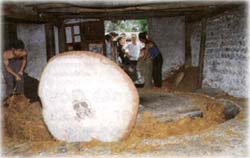
Stone roller grinding fermented and boiled bamboo
Looking down from a high place, we can wee large and small steaming and boiling kilns, fermenting pools and lime pits scattered all over like stars in the sky, as if to tell and sing a story of long, long ago. Near high and low thatched cottages are papermaking workshops and a water-powered mill wheel.
The local records say that the papermaking industry there began 300 years ago, in the late Ming and early Qing dynasties. Later it flourished during Qing emperor Qian Long's reign(1736-1796), and the number of papermaking households increased from three to a dozen. Every household had eight kilns, with a monthly rough-straw paper (or toilet paper) output of 150 kg. At that time, hand production included husking bamboo and hemp with pestles and mortars. Today, such primitive means of production can still be seen in Xieyao Village, Changshun, 30 kilometers from Huishui.
In the early 20th century, Dongkou's papermaking industry spread to more than 100 households. The husking of bamboo and hemp was then done by water- or ox-powered roller. In the 1940s, papermaking there became more flourishing, and production spread to 150 households, with a total of 300 kilns. The number of papermaking workshops grew to 180, grinding 1.5 million kilograms of bamboo raw materials a year with 60 rollers. Its annual output was 0.5 million tons of rough-straw paper. Today, both rough-straw paper and paper money are good sellers in all corners of the province.
To make rough-straw paper takes two kinds of bamboo as raw materials, with the addition of birch leaves, lime and water. Generally, the paper, called zhuma (bamboo hemp), is clean and is a good absorbent. One special use is for putting under corpses.
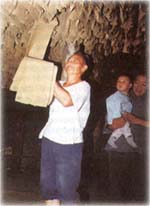
Collected dried paper
After being rinsed in river water, it is again steamed and boiled for another ten days before being ground into pieces and put into a pool of pure water. After mucilage from birch leaves has been added, it is then strained. The residue is the pulp raw material.
Originally, papermakers used bamboo curtains to hang the sheets of pulp on till they dried to the constituency of damp paper. Later, the remaining water was squeezed out.
Invented origami - which originated with the wealthy people in China - when they used expensive paper to write to friends. Before they sent the letters, they folded them up into fancy designs.
They also modified paper to make raincoats, windows, umbrellas, they used a lot of paper in their houses even windows!
Many of the children's toys were made out of paper
Armor for war was made from strengthened paper
The Chinese had many natural remedies some of which included natural herbs and acupuncture.
The discovery of medicine in ancient China started more than 2,000 years ago. In Ancient China, the Chinese's goal to make medicine was to make an elixir of life to make emperors immortal and help them live eternally. Eventually, in their quest to make an elixir of life, they made series of medicines and remedies. That is how China began the search for medicine.
An elixir of life is a potion that the Chinese believed would make you live forever. The Chinese believed that this liquid potion was made from the gods, and whoever drank it would be rewarded with eternity, which means you would live forever. The Chinese wanted to try to make an elixir because they wanted to make the emperors immortal. That is why the ancient Chinese tried to discover a potion that would make you eternal.
The idea to discover an elixir and the science of medicine was influenced by Tao Ch'ien, a famous poet and philosopher.
In his poetry and philosophy, he believed that if the Chinese discovered a method of turning metal into gold, which would last forever, they would at the same time discover the elixir of life.
With this belief, doctors and pharmacologists began to search madly for a technique to make metal into gold. This belief also made doctors try to discover other ways to make people immortal, and that led to the making of the elixir.
After creating many medicines (such as herbal medicines like an Euryale seed which treated urination problems and animal organs, like the pig's liver, that helped someone's eyesight) which were discovered during the rush to make an elixir of life, Tsou Yen, a pharmacologist, formed a theory on how he thought diseases were caused. He believed two spirit-like life forces called Yin and Yang flowed through the body. He said that diseases were thought to be caused when either Yin or Yang were out of balance. After his belief was spread, many doctors in China tried to make a way to make the Yin and Yang balanced inside the body. This was when a pretty famous treatment was made, which is still used today.
About a century after the discovery of medicine, acupuncture was invented in China.
Acupuncture is a treatment, which doesn't involve any drugs. Needles are put in certain parts of the person's body. The Chinese believed that if you put the needles in those specific spots, Yin and Yang would be balanced. When the forces were balanced, it was believed to relieve your pain and you wouldn't get any diseases. That treatment was the most commonly used one at the time.
Later in the years, Chinese medicine was becoming a little bit more advanced. Once again, Tsou Yen turned medicine-making into a science. He wrote theories about elements, and he made a system of rules of classifying large and small objects. Shen Nong then put herbal medicine in two categories: "Four Spirits" and "Five Tastes". Shen thought that if drugs or any other medicines that made your body respond to either cold, hot, warm, or cool, they would go in the "Four Spirits" group. If a medicine is sour, bitter, hot, sweet, or salty when it was tasted, it would be in the "Five Tastes" group.
These discoveries and events led to the invention of medicine. If the Chinese did not discover medicine, today's doctors would not have such advanced medicine we have today. The modern world has benefited on the inventions and discoveries made by China.
One of the most famous doctors was Tao Chi'en. He was the first to influence doctors to make a study of elixirs. He was also the one to pass the belief that if the Chinese discovered a method to make metal into gold, they would at the same time discover the elixir of life. With this belief, Li Shao-Chun was the first to make an attempt on making a metal to gold.
Li Shao-Chun was the first doctor, or pharmacologist, mentioned in early Chinese records. He was the one to pass a belief that gold made from a red metal called cinnabar could make a person immortal. He said if a man ate from dishes made from that gold, the man would be rewarded with eternal life by the goddess, Spirit of the Furnace. This belief of his was influenced by Tao Chi'en's thought. Soon many doctors spread many theories about making gold for the emperors.
A poet named Ko Hung organized most of the beliefs about making the immortal gold in a book. In his book, he also put formulas for making elixirs of life. Ko was the first to put all the methods of turning metal into gold and all the ways of making elixirs into a book.
Later in the years, people believed that doctors could bring people back to life. The people thought this because a famous doctor named Bian Que had brought a prince "back to life" in the year 201 B.C.
This happened when he went to the state called Guo, and he saw a funeral of a prince going on in the state. The prince was dead for half the day, but Bian Que went to the body and did acupuncture on the prince's wrists and thighs. He also gave the prince many drugs and herbs. Soon, the prince came out of his coma and he was alive again!!!! The people were so amazed that Bian Que was named the Shaman of Life!
In 100 B.C., Shen Nong invented the first set of herbal medicines. He had made a graph full of herbs and their uses. He also showed a lot of doctors how the herbal medicine was made. With this discovered, Tao Hung Ching put all of Shen Nong's knowledge of herbs into a book. Herbal medicine had been invented in 100 B.C..
In Hong Kong, Alexander Yersin discovered the first identified parasite in China called the Yersinia Pestis. A parasite is a tiny little germ that you cannot see, but it could enter your skin and cause disease. This parasite was found in most of the diseases in China such as Malaria which is when a mosquito injects some sickening juice in you skin. After finding a parasite, many Chinese doctors developed a series of remedies to stop this parasite. This was the first parasite discovered in China.
Li Shizen was a famous pharmacologist noted in Chinese records, too. He traveled through China to find every medical achievement there was. He then summarized them from his time, and he listed the 1,892 herbs and listed the 11,000 prescriptions in a book. He also corrected mistakes in some medicine uses and he classified all the herbs used in medicine.
There were many interesting ways to make medicine in ancient China. The ingredients for China's unique medicines were mostly herbs. Of course, there were no supermarkets and malls to go to buy the things for medicine. So, to get the stuff for medicine, most doctors had to get their herbs from a farmer, or some doctors grew their herbs by themselves. But the long process to make remedies was very exhausting. The first step for making the ancient medicine was to grow the herbs in the fields of China.
The Chinese had learned how to grow herbs and raise animals 4,000 years ago. The Chinese grew their herbs in mountainous terrains and narrow terraces, which are grassy fields that have a series of banks. In the terrains, they grew their herbs in a rich, yellow soil called loess. It was said that loess was blown in from the Mongolian Desert. To cut the herbs from the fields, they used a wooden knife, called a Leem, to cut the weeds. After getting the herbs, the herbs were given to the doctors. That was how the doctors got the herbs.
The herbs were dried by the sun. The herbs were left there for a couple of hours. After it was dried, it was then soaked in cold water. Next, the doctor or pharmacologist took the herb and he/she mashed the herb into a powder with a wooden cylinder bar. After that, they took the powder and mixed it with some water and stirred it to form a liquid. After this procedure, the herbal medicine is done. Some of the liquidized herbs were potable, but other herbs were rubbed on your skin if you had skin disease and fractured bones. That was how they made some of the herbal medicines.
Not all medicines were herbs. Some of them used animal organs or animal parts. To get the organs, the doctors cut the animal with a bronze knife. They took out the organs that were good for sicknesses, such as a sheep's eye. The organs or parts were cleaned in water, then the parts were given to patients for them to eat so that patient could be cured. The rest of the body of the animal was dried and stretched on a stick. To eat it, the people had to boil it in water.
In Ancient times, the Chinese believed that two dragon spirits could be in your heart. They were the black dragon, and the white dragon. The black dragon spirit represented bad luck and evil. The white dragon spirit represented eternity and good luck. Each spirit was believed to be in a person's heart, and either the black or white one lived in your heart. In order to know if you either have the white or black dragon spirit in you, a doctor has to inspect your tongue.
The Chinese believed if your tongue's color was yellow, it would mean that fire from the dragon has risen in your stomach. If your tongue has a purple color, that means that your heart is pumping unhealthy blood. If you had a yellow or a purple tongue, the Chinese believed that you would have the black dragon spirit. You would have the white dragon spirit if you had a healthy red tongue. This was one of Ancient China's religious beliefs, and with this belief, the Chinese doctors discovered a way to rid the black dragon spirit. It is called the heat treatment.
The heat treatment was another treatment used in ancient China. For this process, a doctor places a needle in your skin, and the doctor burns mugwort, an herb. The heat from the burning mugwort is carried through the needle and into the body. This was supposed to relax your mind and to excite your spirit. If you had the black dragon spirit in you, the Chinese believed the heat treatment could make it go away.
In Ancient China, there were people who had a lot of sicknesses and diseases such as skin disease, urination problems, chicken pox, and lack of energy. To get treated, these people had to go to the village doctor. If you went there and you had asthma or you were depressed, the doctor would cure it by letting you eat some ginseng weed, which is an herb.
There were many other medicines that helped the people. If you had skin problems, the medicine the ancient Chinese would give you to eat would be dried sea horse. If you were a man and you thought you needed more energy in your sex life then the ancient Chinese would give you some dried gecko for you to cook and eat. There were many other medicines that had numerous nutrients and minerals such as the cow stomach which has a lot of iron in it, or the sheep's eye which has many vitamins in it.
History of Traditional Chinese Medicine
Beijing, Xinhua - Chinese surgeons were able to perform a craniotomy, the surgical opening of the skull, which is difficult even in modern times, as early as 4,000 years ago. This is contrary to archaeologists' previous belief that the craniotomy was introduced to China by Arabs after the Tang Dynasty (618-907).
In the latest issue of the journal Archaeology, Han Kangxin and Chen Xingcan, of the Chinese Academy of Social Sciences' Institute of Archaeology, say that several ancient skulls with holes on them were discovered at sites in Qinghai, Henan, Heilongjiang provinces. Carbon dating indicates that the skull, which was found in a tomb in Minhe County in Qinghai, is the oldest to have had this operation in China and was from the later New Stone Age, about 4, 000 years ago.
A large triangular cut can be found at the top of the skull with traces of scraping around it. There are also two sunken traces on the skull, which Han says might have been left by a strike from a certain instrument, causing a fracture and inflammation of the skull. There were some bony growths around the hole and the scraped traces are indistinct, he says, meaning that the patient survived for a period of time after the operation.
Silk Road
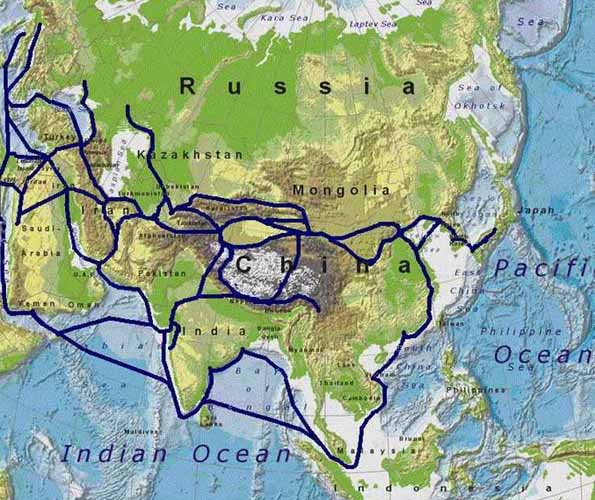
The Silk Road, or Silk Route, is a series of trade routes through regions of the Asian continent mainly connecting Chang'an (today's Xi'an) in China, with Asia Minor and the Mediterranean.
It extends over 8,000 km (5,000 miles) on land and sea. Trade on the Silk Road was a significant factor in the development of the great civilizations of China, Egypt, Mesopotamia, Persia, Indian subcontinent, and Rome, and helped to lay the foundations for the modern world. The first person who used the term Silk Road was the German geographer Ferdinand von Richthofen in 1877.
Routes Taken - Cities along the Silk Road
As it extends westwards from the commercial centers of North China, the continental Silk Road divides into north and south routes to avoid the Tibetan Plateau.
The northern route passes through the BulgarÐKypchak region. It travels northwest through the Chinese province of Gansu, and splits into three further routes, two of them passing north and south of the Taklamakan Desert (through modern day Kyrgyzstan and Xinjiang) to rejoin at Kashgar; and the other going north of the Tien Shan mountains through Turfan and Almaty (in what is now southeast Kazakhstan). All routes join up at Kokand in the Fergana Valley, and the roads continue east across the Karakum Desert towards Merv, joining the northern route briefly.
One of these routes turns southeast along the Amu Darya (river) including Bukhara and Samarkand the center of Silk Road trade to the Aral Sea, through ancient civilizations under the present site of Astrakhan, and on to the Crimean peninsula. From there it crosses the Black Sea, Marmara Sea and the Balkans to Venice, another crosses the Caspian Sea and across the Caucasus to the Black Sea in Georgia, thence to Constantinople.
The southern route is mainly a single route running through northern India, then the TurkestanÐKhorasan region into Mesopotamia and Anatolia; having southward spurs enabling the journey to be completed by sea from various points. It runs south through the Sichuan Basin in China and crosses the high mountains into northeast India, probably via the Ancient tea route. It then travels west along the Brahmaputra and Ganges river plains, possibly joining the Grand Trunk Road west of Varanasi. It runs through northern Pakistan and over the Hindu Kush mountains to rejoin the northern route briefly near Merv.
It then followed an almost straight line west through mountainous northern Iran and the northern tip of the Syrian Desert to the Levant. From there Mediterranean trading ships plied regular routes to Italy, and land routes went either north through Anatolia or south to North Africa.
Another branch traveled from Herat through Susa to Charax Spasinu at the head of the Persian Gulf and across to Petra and Alexandria from where ships carried the cargoes to Rome and other Mediterranean ports.
As long as two thousand years ago, during the Eastern Han Dynasty in China, the sea route led from the mouth of the Red River near modern Hanoi, all the way through the Malacca Straits to Southeast Asia, Sri Lanka and India, and then on to the Persian Gulf and the Red Sea. From ports on the Red Sea goods, including silks, were transported overland to the Nile and then down to Alexandria from where they were shipped to Rome and other Mediterranean ports.
Another branch of these sea routes led down the East African coast (called Azania by the Greeks and Romans and Zesan by the Chinese) at least as far as the port known to the Romans as Rhapta, which was probably located in the delta of the Rufiji River in modern Tanzania.
The Silk Road on the Sea extends from southern China to present day Brunei, Thailand, Malacca, Ceylon, India, Pakistan, the Philippines, and Iran. In Europe it extends from Israel, Lebanon, Egypt, and Italy in the Mediterranean Sea to Portugal and Sweden.
As accomplished waterway shipping and domestication of efficient pack animals both increased the capacity for prehistoric peoples to carry heavier loads over greater distances, cultural exchanges and trade developed rapidly. For example, shipping in predynastic Egypt was already established by the 4th millennium BC along with domestication of the donkey, with the dromedary possibly having been domesticated as well. Domestication of the Bactrian camel and use of the horse for means of transport then followed.
As the domestication of efficient pack animals and the development of shipping technology both increased the capacity for prehistoric peoples to carry heavier loads over greater distances, cultural exchanges and trade developed rapidly.
Just as waterways provide easy means for distant transport, broad stretches of grasslands - all the way from the shores of the Pacific to Africa and deep into the heart of Europe - provide fertile passage for grazing, plus water and fuel for caravans. These waterway and overland routes allowed passage that avoided trespassing on agricultural lands, presenting ideal conditions for caravans, merchants and warriors to travel immense distances without arousing the hostility of more settled peoples.
While goods and religious ideas may have communicated greater distances, ancient trade was probably conducted over only sections of the routes. The Silk Road is unlikely to have been travelled in entirety between Africa, Europe or the Middle East and China by land.
Evidence for Ancient Transport and Trade Routes
Foreign artifacts dating to the 5th millennium BC in the Badarian culture of Egypt indicate contact with distant Syria.
In predynastic Egypt, by the 4th millennium BC shipping was well established, and the donkey and possibly the dromedary had been domesticated. Domestication of the Bactrian camel and use of the horse for transport then followed.
Also by the beginning of the 4th millennium BC, ancient Egyptians in Maadi were importing pottery as well as construction ideas from Canaan.
By the second half of the 4th millennium BC, the gemstone lapis lazuli was being traded from its only known source in the ancient world - Badakshan, in what is now northeastern Afghanistan - as far as Mesopotamia and Egypt. By the 3rd millennium BC, the lapis lazuli trade was extended to Harappa and Mohenjo-daro in the Indus Valley Civilization of modern day Pakistan and northwestern India. The Indus Valley was also known as Meluhha, the earliest maritime trading partner of the Sumerians and Akkadians in Mesopotamia.
Routes along the Persian Royal Road, constructed in the 5th century BC by Darius I of Persia, may have been in use as early as 3500 BC. Charcoal samples found in the tombs of Nekhen, which were dated to the Naqada I and II periods, have been identified as cedar from Lebanon.
In 1994 excavators discovered an incised ceramic shard with the serekh sign of Narmer, dating to circa 3000 BC. Mineralogical studies reveal the shard to be a fragment of a wine jar exported from the Nile valley to Israel.
The ancient harbor constructed in Lothal, India, may be the oldest sea-faring harbour known.
The oldest known expedition to the Land of Punt was organized by Sahure, which apparently yielded a quantity of myrrh, along with malachite and electrum. The 12th-Dynasty Pharaoh Senusret III had a "Suez" canal constructed linking the Nile River with the Red Sea for direct trade with Punt.
Around 1950 BC, in the reign of Mentuhotep III, an officer named Hennu made one or more voyages to Punt. In the 15th century BC, Nehsi conducted a very famous expedition for Queen Hatshepsut to obtain myrrh; a report of that voyage survives on a relief in Hatshepsut's funerary temple at Deir el-Bahri. Several of her successors, including Thutmoses III, also organized expeditions to Punt.
The Tarim mummies, Chinese mummies of an Indo-European type, have been found in the Tarim Basin, such as in the area of Loulan located along the Silk Road 200 kilometers east of Yingpan, dating to as early as 1600 BC and suggesting very ancient contacts between East and West. It has been suggested that these mummified remains may have been the work of the ancestors of the Tocharians whose Indo-European language remained in use in the Tarim Basin (modern day Xinjiang) of China until the 8th century CE.
Some remnants of what was probably Chinese silk have been found in Ancient Egypt from 1070 BC. Though the originating source seems sufficiently reliable, silk unfortunately degrades very rapidly and we cannot double-check for accuracy whether it was actually cultivated silk (which would almost certainly have come from China) that was discovered or a type of "wild silk," which might have come from the Mediterranean region or the Middle East.
Following contacts of metropolitan China with nomadic western and northwestern border territories in the 8th century BC, gold was introduced from Central Asia, and Chinese jade carvers began to make imitation designs of the steppes, adopting the Scythian-style animal art of the steppes (descriptions of animals locked in combat). This style is particularly reflected in the rectangular belt plaques made of gold and bronze with alternate versions in jade and steatite.
It was maintained and protected by the Achaemenid empire (c.700-330 BC) and had postal stations and relays at regular intervals. By having fresh horses and riders ready at each relay, royal couriers could carry messages the entire distance in 9 days, though normal travellers took about three months. This Royal Road linked into many other routes. Some of these, such as the routes to India and Central Asia, were also protected by the Achaemenids, encouraging regular contact between India, Mesopotamia and the Mediterranean. There are accounts in Esther of dispatches being sent from Susa to provinces as far out as India and Cush during the reign of Xerxes (485-465 BC).
Roman and Egyptian transatlantic voyages - In 1975 two intact amphorae were recovered from the bottom of Guanabara Bay, near Rio de Janeiro, Brazil. In 1981 archeologist Robert Marx discovered thousands of pottery fragments in the same locality, including 200 necks from amphorae. The amphorae have been shown to be of Roman make, from the 2nd Century BC.
Also, tests done on internal tissue samples from ancient Egyptian mummies have revealed traces of chemicals only found in the Americas in antiquity, such as tobacco and coca. Because the samples taken from sundry Egyptian mummies were of internal tissues, the likelihood for contamination is smaller.
History
The first major step in opening the Silk Road between the East and the West came with the expansion of Alexander the Great deep into Central Asia, as far as Ferghana at the borders of the modern-day Xinjiang region of China, where he founded in 329 BC a Greek settlement in the city of Alexandria Eschate "Alexandria The Furthest", Khujand (also called Khozdent or Khojent - formerly Leninabad), in the state of Tajikistan.
When Alexander the Great's successors, the Ptolemies, took control of Egypt in 323 BC, they began to actively promote trade with Mesopotamia, India, and East Africa through their ports on the Red Sea coast, as well as overland. This was assisted by the active participation of a number of intermediaries, especially the Nabataeans and other Arabs.
The Greeks were to remain in Central Asia for the next three centuries, first through the administration of the Seleucid Empire, and then with the establishement of the Greco-Bactrian Kingdom in Bactria. They kept expanding eastward, especially during the reign of Euthydemus (230-200 BC), who extended his control to Sogdiana, reaching and going beyond the city of Alexandria Eschate. There are indications that he may have led expeditions as far as Kashgar in Chinese Turkestan, leading to the first known contacts between China and the West around 200 BC. The Greek historian Strabo writes that "they extended their empire even as far as the Seres (China) and the Phryni".
The next step came around 130 BC, with the embassies of the Han Dynasty to Central Asia, following the reports of the ambassador Zhang Qian (who was originally sent to obtain an alliance with the Yuezhi against the Xiong-Nu, in vain).
The Chinese emperor Wudi became interested in developing commercial relationship with the sophisticated urban civilizations of Ferghana, Bactria and Parthia.
The Chinese were also strongly attracted by the tall and powerful horses in the possession of the Dayuan (named "Heavenly horses"), which were of capital importance in fighting the nomadic Xiongnu. The Chinese subsequently sent numerous embassies, around ten every year, to these countries and as far as Seleucid Syria. The Chinese campaigned in Central Asia on several occasion, and direct encounters between Han troops and Roman legionnaires (probably captured or recruited as mercenaries by the Xiong Nu) are recorded, particularly in the 36 BC battle of Sogdiana (Joseph Needham, Sidney Shapiro). It has been suggested that the Chinese crossbow was transmitted to the Roman world on such occasions.
The Chinese army made an alliance with the Parthians and established some forts at a distance of a few days march from the Parthian capital Ctesiphon, planning to hold the region for several years.
In 116 CE, the Roman Emperor Trajan advanced into Parthia to Ctesiphon and came within one day's march of the Chinese border garrisons, but no direct contacts are known.
The Roman Empire and silk - Menade in silk dress, Naples National Museum.Soon after the Roman conquest of Egypt in 30 BCE, regular communications and trade between India, Southeast Asia, Sri Lanka, China, the Middle East, Africa and Europe blossomed on an unprecedented scale. Land and maritime routes were closely linked, and novel products, technologies and ideas began to spread across the continents of Europe, Asia and Africa.
Intercontinental trade and communication became regular, organized, and protected by the 'Great Powers.' Intense trade with the Roman Empire followed soon, confirmed by the Roman craze for Chinese silk (supplied through the Parthians), even though the Romans thought silk was obtained from trees.
The Senate issued, in vain, several edicts to prohibit the wearing of silk, on economic and moral grounds: the importation of Chinese silk caused a huge outflow of gold, and silk clothes were considered to be decadent and immoral.
The Hou Hanshu records that the first Roman envoy arrived in China by this maritime route in 166 CE, initiating a series of Roman embassies to China.
The Kushan empire, in the northwestern part of the Indian subcontinent, was located at the center of these exchanges. They fostered multi-cultural interaction as indicated by their 2nd century treasure hoards filled with products from the Greco-Roman world, China and India, such as in the archeological site of Begram.
The heyday of the Silk Road corresponds to that of the Byzantine Empire in its west end, Sasanid Period to Il Khanate Period in the Nile-Oxus section and Three Kingdoms to Yuan Dynasty in the Sinitic zone in its east end. Trade between East and West also developed on the sea, between Alexandria in Egypt and Guangzhou in China, fostering the expansion of Roman trading posts in India.
Historians also talk of a "Porcelain Route" or "Silk Route" across the Indian Ocean. The Silk Road represents an early phenomenon of political and cultural integration due to inter-regional trade. In its heyday, the Silk Road sustained an international culture that strung together groups as diverse as the Magyars, Armenians, and Chinese.
Under its strong integrating dynamics on the one hand and the impacts of change it transmitted on the other, tribal societies previously living in isolation along the Silk Road or pastoralists who were of barbarian cultural development were drawn to the riches and opportunities of the civilizations connected by the Silk Road, taking on the trades of marauders or mercenaries. Many barbarian tribes became skilled warriors able to conquer rich cities and fertile lands, and forge strong military empires.
The Silk Road gave rise to the clusters of military states of nomadic origins in North China, invited the Nestorian, Manichaean, Buddhist, and later Islamic religions into Central Asia and China, created the influential Khazar Federation and at the end of its glory, brought about the largest continental empire ever: the Mongol Empire, with its political centers strung along the Silk Road (Beijing in North China, Karakorum in central Mongolia, Sarmakhand in Transoxiana, Tabriz in Northern Iran, Astrakhan in lower Volga, Bahcesaray in Crimea, Kazan in Central Russia, Erzurum in eastern Anatolia), realizing the political unification of zones previously loosely and intermittently connected by material and cultural goods.
The Roman empire, and its demand for sophisticated Asian products, crumbled in the West around the 5th century. In Central Asia, Islam expanded from the 7th century onward, bringing a stop to Chinese westward expansion at the Battle of Talas in 751 CE.
Further expansion of the Islamic Turks in Central Asia from the 10th century finished disrupting trade in that part of the world, and Buddhism almost disappeared.
Artistic transmission on the Silk Road - Buddhist deities - The image of the Buddha, originating during the 1st century CE in northern India (areas of Gandhara and Mathura) was transmitted progressively through Central Asia and China until it reached Japan in the 6th century CE.
However the transmission of many iconographical details is clear, such as the Hercules inspiration behind the Nio guardian deities in front of Japanese Buddhist temples, and also representations of the Buddha reminiscent of Greek art such as the Buddha in Kamakura.
Another Buddhist deity, Shukongoshin, is also an interesting case of transmission of the image of the famous Greek god Herakles to the Far-East along the Silk Road. Herakles was used in Greco-Buddhist art to represent Vajrapani, the protector of the Buddha, and his representation was then used in China and Japan to depict the protector gods of Buddhist temples.
The Roman historian Florus also describes the visit of numerous envoys, included Seres (Chinese), to the first Roman Emperor Augustus, who reigned between 27 BCE and 14 CE.
Floral scroll pattern - Finally the Greek artistic motif of the floral scroll was transmitted from the Hellenistic world to the area of the Tarim Basin around the 2nd century CE, as seen in Serindian art and wooden architectural remains. It then was adopted by China between the 4th and 6th centuries CE and displayed on tiles and ceramics; then it transmitted to Japan in the form of roof tile decorations of Japanese Buddhist temples circa 7th century CE, particularly in Nara temple building tiles, some of them exactly depicting vines and grapes.
Westerners became more aware of the Far East when Polo documented his travels in Il Milione.
He was followed by numerous Christian missionaries to the East, such as William of Rubruck, Giovanni da Pian del Carpini, Andrew of Longjumeau, Odoric of Pordenone, Giovanni de Marignolli, Giovanni di Monte Corvino, and other travellers such as Ibn Battuta or Niccolo Da Conti. Luxury goods were traded from one middleman to another, from China to the West, resulting in high prices for the trade goods.
Chinese maps such as the Kangnido and islamic mapmaking seem to have influenced the emergence of the first practical world maps, such as those of De Virga or Fra Mauro. Ramusio, a contemporary, states that Fra Mauro's map is "an improved copy of the one brought from Cathay by Marco Polo".Large Chinese junks were also observed by these travelers and may have provided impetus to develop larger ships in Europe. ships were also observed.
However, with the disintegration of the Mongol Empire also came discontinuation of the Silk Road's political, cultural and economic unity. Turkmeni marching lords seized the western end of the Silk Road - the decaying Byzantine Empire. After the Mongol Empire, the great political powers along the Silk Road became economically and culturally separated. Accompanying the crystallization of regional states was the decline of nomad power, partly due to the devastation of the Black Death and partly due to the encroachment of sedentary civilizations equipped with gunpowder.
The effect of gunpowder and early modernity on Europe was the integration of territorial states and increasing mercantilism; whereas on the Silk Road, gunpowder and early modernity had the opposite impact: the level of integration of the Mongol Empire could not be maintained, and trade declined (though partly due to an increase in European maritime exchanges).
The great explorers: Europe reaching for Asia - The disappearance of the Silk Road following the end of the Mongols was one of the main factors that stimulated the Europeans to reach the prosperous Chinese empire through another route, especially by the sea. Tremendous profits were to be obtained for anyone who could achieve a direct trade connection with Asia.
When he went West in 1492, Christopher Columbus reportedly wished to create yet another Silk Route to China. It was allegedly one of the great disappointments of western nations to have found a continent "in-between" before recognizing the potential of a "New World."
The wish to trade directly with China was also the main drive behind the expansion of the Portuguese beyond Africa after 1480, followed by the powers of the Netherlands and Great Britain from the 17th century.
As late as the 18th century, China was usually still considered the most prosperous and sophisticated of any civilization on Earth.
The Great Wall of China
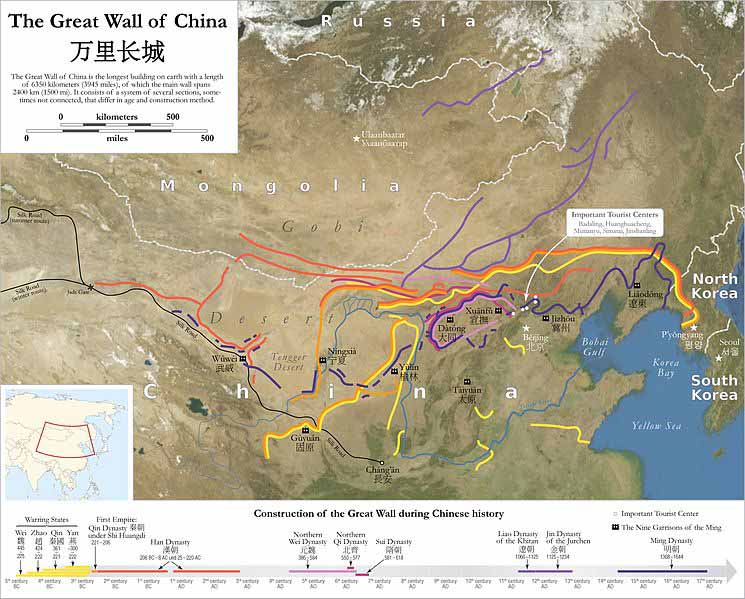
The Great Wall of China is a series of fortifications made of stone, brick, tamped earth, wood, and other materials, generally built along an east-to-west line across the historical northern borders of China in part to protect the Chinese Empire or its prototypical states against intrusions by various nomadic groups or military incursions by various warlike peoples or forces. It is included in lists of the "Seven Medieval Wonders of the World" but was of course not one of the classical Seven Wonders of the World recognized by the ancient Greeks. The Wall was made a UNESCO World Heritage Site in 1987.
Size
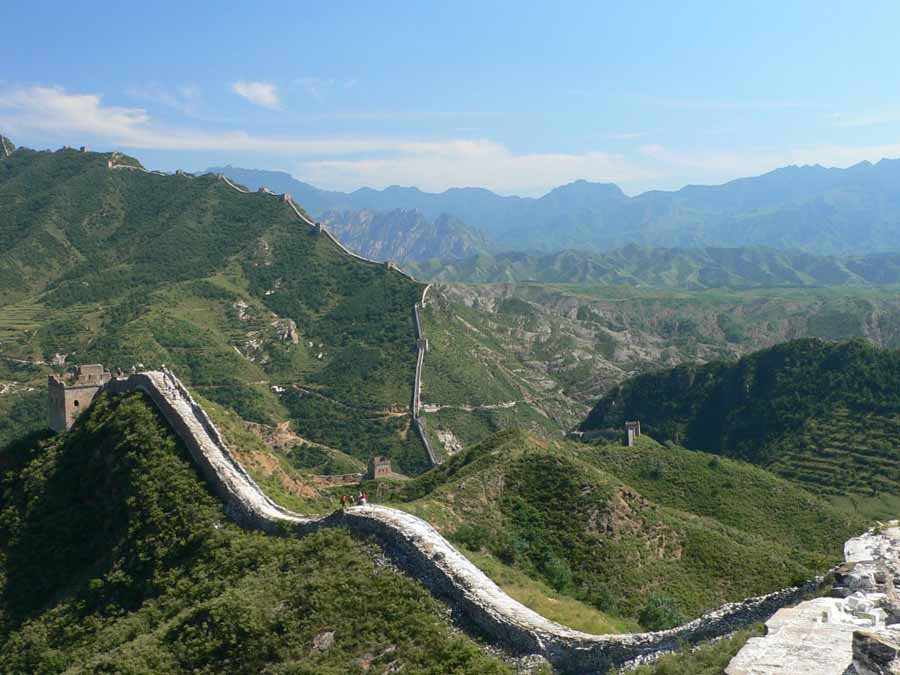
The Great Wall of China has been officially declared even longer than previously thought, state-run media report. The wall measures 21,196.18km (13,170.6956 miles) long based on the latest state survey results, state-run news agency Xinhua reported today.
History
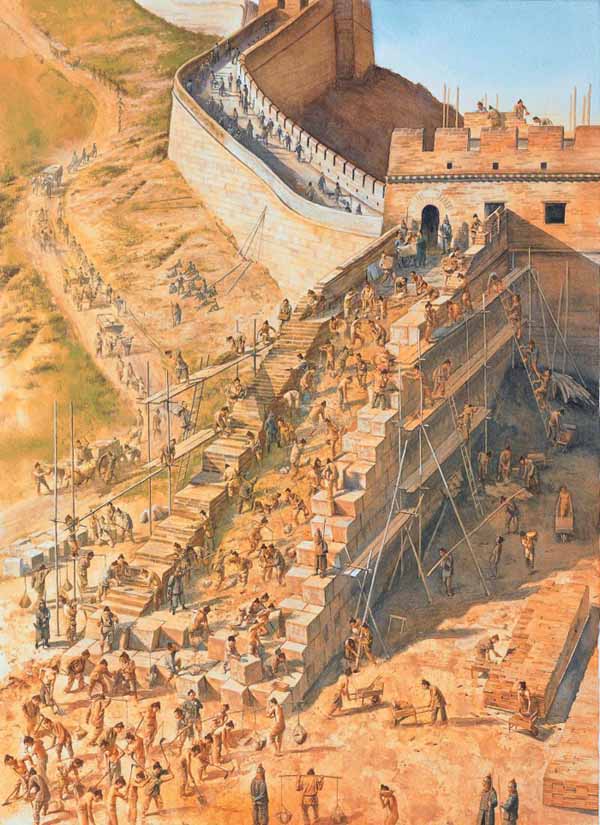
The first major wall was built during the reign of the First Emperor, the main emperor of the short-lived Qin dynasty. This wall was not constructed as a single endeavor, but rather was created by the joining of several regional walls built by the Warring States. It was located much further north than the current Great Wall, and very little remains of it. A defensive wall on the northern border was built and maintained by several dynasties at different times in Chinese history.
Several walls were being built as early as the 7th century BC; these, later joined together and made bigger, stronger, and unified are now collectively referred to as the Great Wall. Especially famous is the wall built between 220-206 BC by the first Emperor of China, Qin Shi Huang. Little of that wall remains. Since then, the Great Wall has on and off been rebuilt, maintained, enhanced; the majority of the existing wall was reconstructed during the Ming Dynasty.
The Great Wall that can still be seen today was built during the Ming Dynasty, on a much larger scale and with longer lasting materials (solid stone used for the sides and the top of the Wall) than any wall that had been built before. The primary purpose of the wall was not to keep out people, who could scale the wall, but to insure that semi-nomadic people on the outside of the wall could not cross with their horses or return easily with stolen property.
Other purposes of the Great Wall have included border controls, allowing the imposition of duties on goods transported along the Silk Road, regulation or encouragement of trade and the control of immigration and emigration. Furthermore, the defensive characteristics of the Great Wall were enhanced by the construction of watch towers, troop barracks, garrison stations, signaling capabilities through the means of smoke or fire, and the fact that the path of the Great Wall also served as a transportation corridor.
There have been four major walls:
- 208 BC (the Qin Dynasty)
1st century BC (the Han Dynasty)
1138 - 1198 (the Five Dynasties and Ten Kingdoms Period)
1368-1620 (from Hongwu Emperor until Wanli Emperor of the Ming Dynasty)
Qin Shi Huang conquered all opposing states and unified China in 221 BC, establishing the Qin Dynasty. Intending to impose centralized rule and prevent the resurgence of feudal lords, he ordered the destruction of the wall sections that divided his empire along the former state borders. To protect the empire against intrusions by the Xiongnu people from the north, he ordered the building of a new wall to connect the remaining fortifications along the empire's new northern frontier.
Transporting the large quantity of materials required for construction was difficult, so builders always tried to use local resources. Stones from the mountains were used over mountain ranges, while rammed earth was used for construction in the plains. The peasants who died working were buried inside the wall, to be unearthed later by archaeologists. There are no surviving historical records indicating the exact length and course of the Qin Dynasty walls. Most of the ancient walls have eroded away over the centuries, and very few sections remain today. Possibly as many as one million people died building the Wall under the Qin Dynasty.
Later, the Han, Sui, Northern and Jin dynasties all repaired, rebuilt, or expanded sections of the Great Wall at great cost to defend themselves against northern invaders.
The Great Wall concept was revived again during the Ming Dynasty following the Ming army's defeat by the Oirats in the Battle of Tumu in 1449. The Ming had failed to gain a clear upper-hand over the Mongols after successive battles, and the long-drawn conflict was taking a toll on the empire. The Ming adopted a new strategy to keep the nomadic Mongols out by constructing walls along the northern border of China. Acknowledging the Mongol control established in the Ordos Desert, the wall followed the desert's southern edge instead of incorporating the bend of the Huang He.
Unlike the earlier Qin fortifications, the Ming construction was stronger and more elaborate due to the use of bricks and stone instead of rammed earth. As Mongol raids continued periodically over the years, the Ming devoted considerable resources to repair and reinforce the walls. Sections near the Ming capital of Beijing were especially strong.
Towards the end of the Shun Dynasty, the Great Wall helped defend the empire against the Manchu invasions that began around 1600. Under the military command of Yuan Chonghuan, the Ming army held off the Manchus at the heavily fortified Shanhaiguan pass, preventing the Manchus from entering the Liaodong Peninsula and the Chinese heartland. The Manchus were finally able to cross the Great Wall in 1644, when the gates at Shanhaiguan were opened by Wu Sangui, a Ming border general who disliked the activities of rulers of the Shun Dynasty. The Manchus quickly seized Beijing, and defeated the newly founded Shun Dynasty and remaining Ming resistance, to establish the Qing Dynasty.
Under Qing rule, China's borders extended beyond the walls and Mongolia was annexed into the empire, so construction and repairs on the Great Wall were discontinued. A counterpart wall to the Great Wall in the south was erected to protect and divide the Chinese from the 'southern barbarians' called Miao (meaning barbaric and nomadic).
Before the use of bricks, the Great Wall was mainly built from earth, stones, and wood.
During the Ming Dynasty, however, bricks were heavily used in many areas of the wall, as were materials such as tiles, lime, and stone. The size and weight of the bricks made them easier to work with than earth and stone, so construction quickened. Additionally, bricks could bear more weight and endure better than rammed earth. Stone can hold under its own weight better than brick, but is more difficult to use. Consequently, stones cut in rectangular shapes were used for the foundation, inner and outer brims, and gateways of the wall. Battlements line the uppermost portion of the vast majority of the wall, with defensive gaps a little over 30 cm (one foot) tall, and about 23 cm (9 inches) wide.
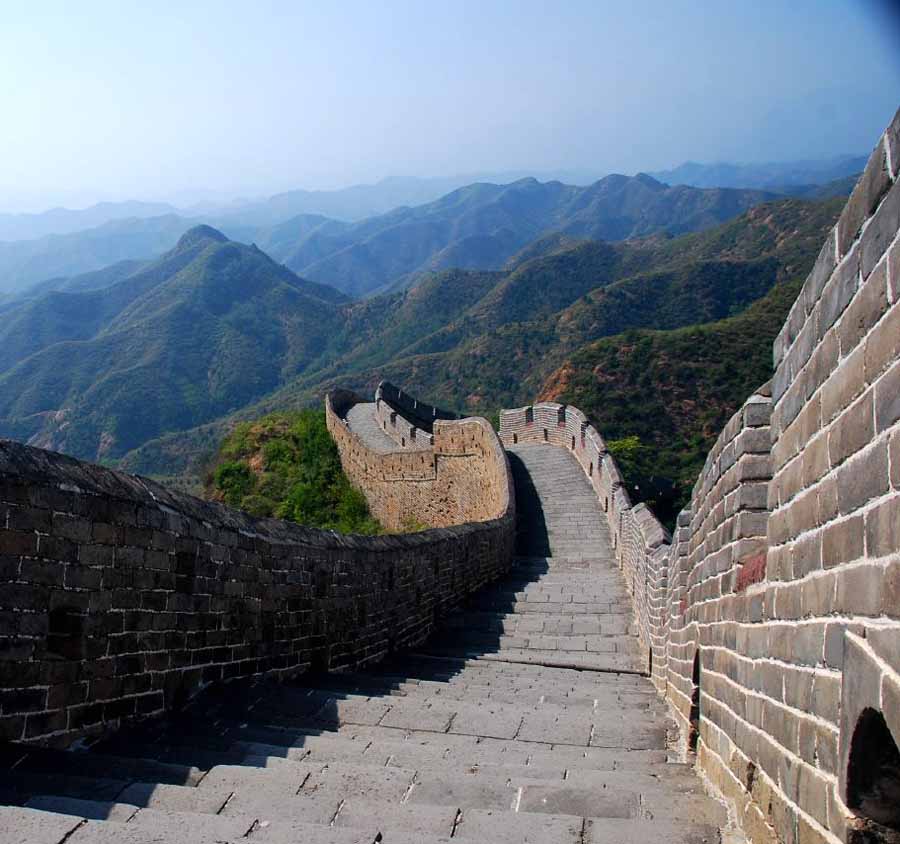
Tourists often become exhausted climbing the wall and walk no more than a kilometre or two (around a mile).

Notable Areas
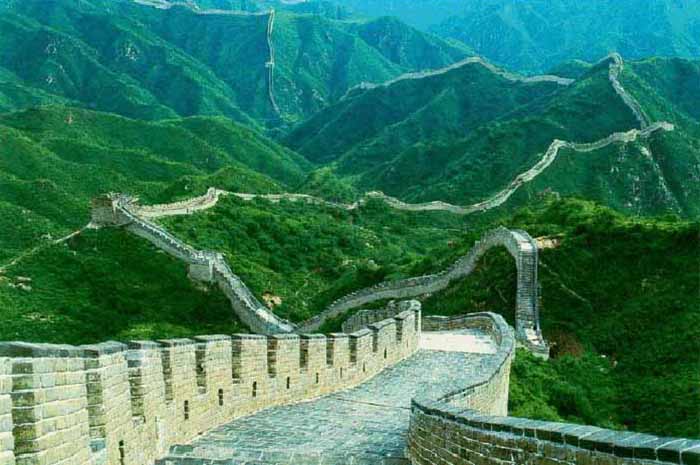
Cragged mountains from the southeast to the northwest for approximately 2.25 kilometers (about 1.3 miles).
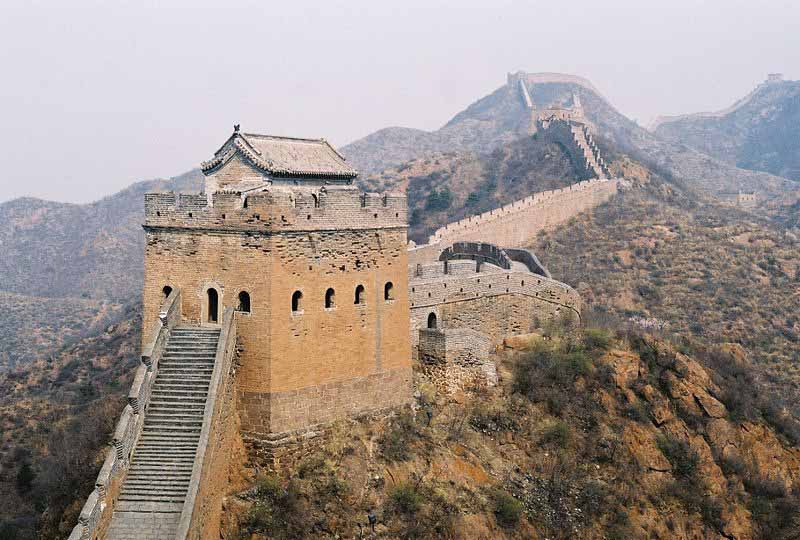
This is the first mountain the Great Wall climbs and only portion of the wall that was built as a bridge.
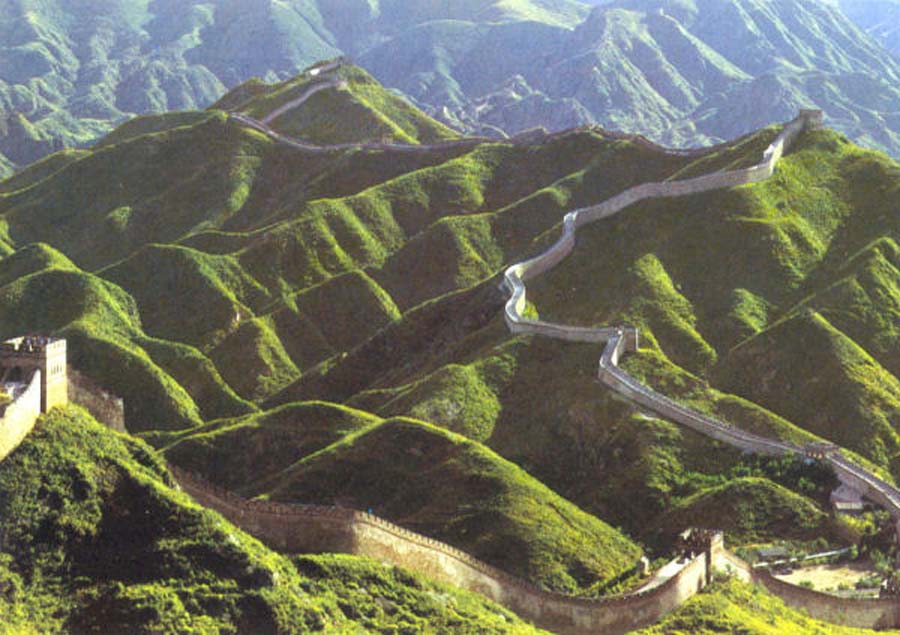
North Pass of Juyongguan. When used by the Chinese to protect their land, this section of the wall has had many guards to defend China's capita, Beijing. Made of stone and bricks from the hills, this portion of the Great Wall is 7.8 meters (25.6 ft) high and 5 meters (16.4 ft) wide.
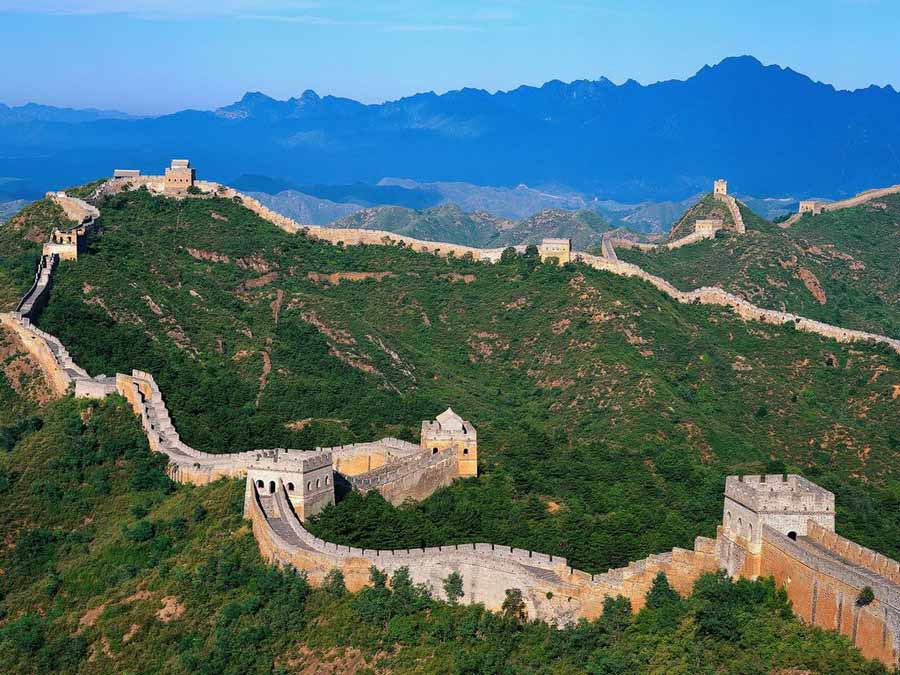
This is where the wall climbs extremely steep slopes. It runs 11 kilometers (7 mi) long, ranges from 5 to 8 meters (16-26 ft) in height, and 6 meters (19.7 ft) across the bottom, narrowing up to 5 meters (16.4 ft) across the top. Wangjinglou is one of Jinshanling's 67 watchtowers, 980 meters (3,215 ft)above sea level.
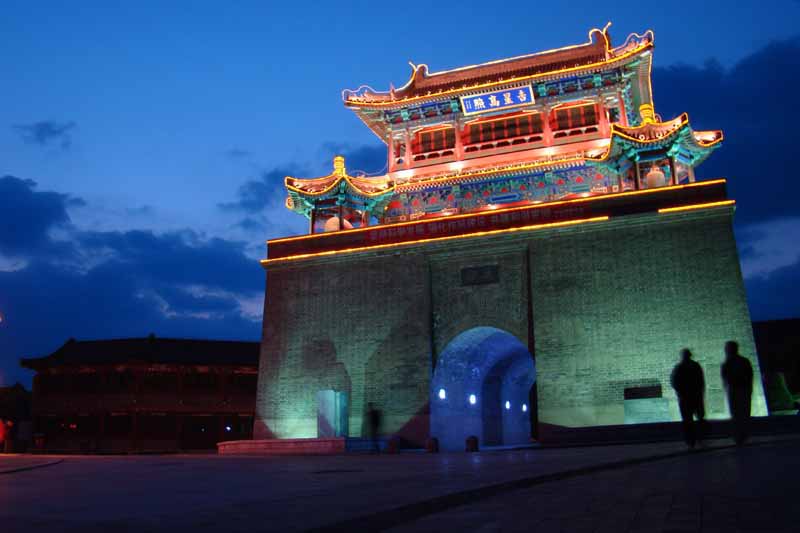
The "Museum of the Construction of the Great Wall",
because of the Meng Jiang-Nu Temple, built during the Song Dynasty.
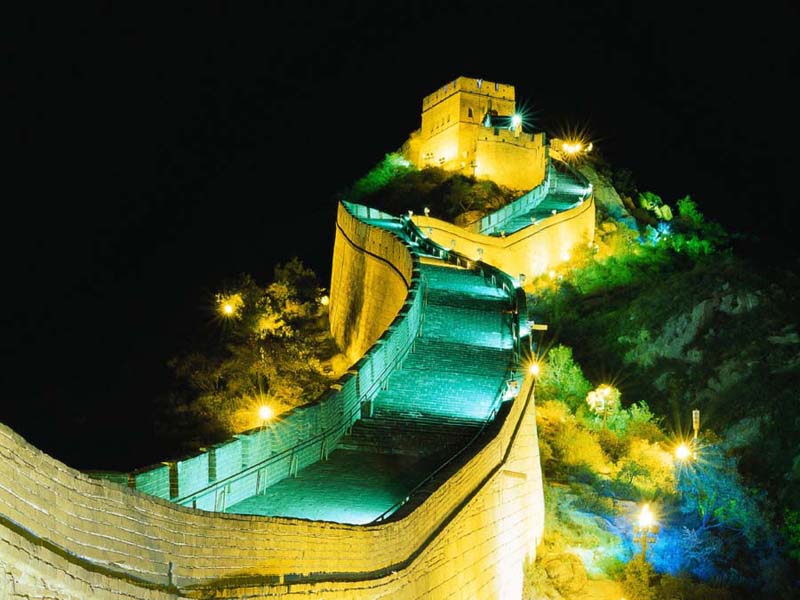
Condition
While some portions north of Beijing and near tourist centers have been preserved and even reconstructed, in many locations the Wall is in disrepair. Those parts might serve as a village playground or a source of stones to rebuild houses and roads.
Sections of the Wall are also prone to graffiti and vandalism. Parts have been destroyed because the Wall is in the way of construction. No comprehensive survey of the wall has been carried out, so it is not possible to say how much of it survives, especially in remote areas. Intact or repaired portions of the Wall near developed tourist areas are often frequented by sellers of tourist kitsch.
More than 60 kilometres (37 mi) of the wall in Gansu province may disappear in the next 20 years, due to erosion from sandstorms. In places, the height of the wall has been reduced from more than five meters (16.4 ft) to less than two meters. The square lookout towers that characterize the most famous images of the wall have disappeared completely. Many western sections of the wall are constructed from mud, rather than brick and stone, and thus are more susceptible to erosion.
The materials used are those available near the site of construction. Near Beijing the wall is constructed from quarried limestone blocks. In other locations it may be quarried granite or fired brick. Where such materials are used, two finished walls are erected with earth and rubble fill placed in between with a final paving to form a single unit. In some areas the blocks were cemented with a mixture of glutinous rice and eggwhite. In the extreme western desert locations, where good materials are scarce, the wall was constructed from dirt rammed between rough wood tied together with woven mats.
Visibility from Space
The claim was also mentioned by Henry Norman in 1895 where he states "besides its age it enjoys the reputation of being the only work of human hands on the globe visible from the moon." The issue of "canals" on Mars was prominent in the late 19th century and may have led to the belief that long, thin objects were visible from space. The claim that the Great Wall is visible also appears in 1932's Ripley's Believe it or Not strip and in Richard Halliburton's 1938 book Second Book of Marvels.
The claim the Great Wall is visible has been debunked many times, but is still ingrained in popular culture. The wall is a maximum 9.1 m (30 ft) wide, and is about the same color as the soil surrounding it. Based on the optics of resolving power (distance versus the width of the iris: a few millimeters for the human eye, meters for large telescopes) only an object of reasonable contrast to its surroundings which is 70 mi (110 km) or more in diameter (1 arc-minute) would be visible to the unaided eye from the moon, whose average distance from Earth is 384,393 km (238,851 mi). The apparent width of the Great Wall from the moon is the same as that of a human hair viewed from 2 miles (3.2 km) away. To see the wall from the moon would require spatial resolution 17,000 times better than normal (20/20) vision. Unsurprisingly, no lunar astronaut has ever claimed to have seen the Great Wall from the moon.
Astronaut William Pogue thought he had seen it from Skylab but discovered he was actually looking at the Grand Canal of China near Beijing. He spotted the Great Wall with binoculars, but said that "it wasn't visible to the unaided eye." U.S. Senator Jake Garn claimed to be able to see the Great Wall with the naked eye from a space shuttle orbit in the early 1980s, but his claim has been disputed by several U.S. astronauts. Veteran U.S. astronaut Gene Cernan has stated: "At Earth orbit of 100 miles (160 km) to 200 miles (320 km) high, the Great Wall of China is, indeed, visible to the naked eye." Ed Lu, Expedition 7 Science Officer aboard the International Space Station, adds that, "it's less visible than a lot of other objects. And you have to know where to look."
In 2001, Neil Armstrong stated about the view from Apollo 11: "I do not believe that, at least with my eyes, there would be any man-made object that I could see. I have not yet found somebody who has told me they've seen the Wall of China from Earth orbit. ...I've asked various people, particularly Shuttle guys, that have been many orbits around China in the daytime, and the ones I've talked to didn't see it."
In October 2003, Chinese astronaut Yang Liwei stated that he had not been able to see the Great Wall of China. In response, the European Space Agency (ESA) issued a press release reporting that from an orbit between 160 and 320 km, the Great Wall is visible to the naked eye. In an attempt to further clarify things, the ESA published a picture of a part of the ÒGreat WallÓ photographed from Space. However, in a press release a week later (no longer available in the ESAÕs website), they acknowledged that the "Great Wall" in the picture was actually a river.
Leroy Chiao, a Chinese-American astronaut, took a photograph from the International Space Station that shows the wall. It was so indistinct that the photographer was not certain he had actually captured it. Based on the photograph, the China Daily later reported that the Great Wall can be seen from space with the naked eye, under favorable viewing conditions, if one knows exactly where to look.[38] However, the resolution of a camera can be much higher than the human visual system, and the optics much better, rendering photographic evidence irrelevant to the issue of whether it is visible to the naked eye.
Battle Forts and Watch Towers

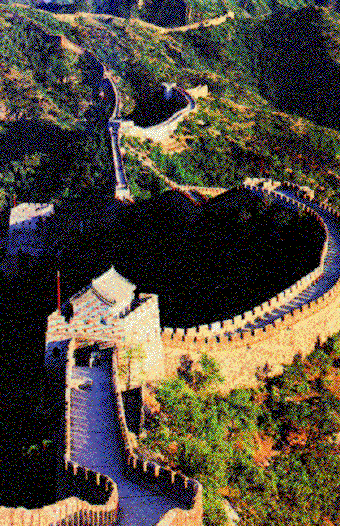
The Mutianyu section of the Great Wall, 70 kilometers northeast of Beijing, is linked to the Gubeikou section on the east and the Badaling section on the west. It is one of the best sections of Great Wall. The Mutianyu section is crenellated for watching and shooting at the invading enemy. Some of the battle forts on the wall are as close as 50 meters apart.

Chinese Dragons
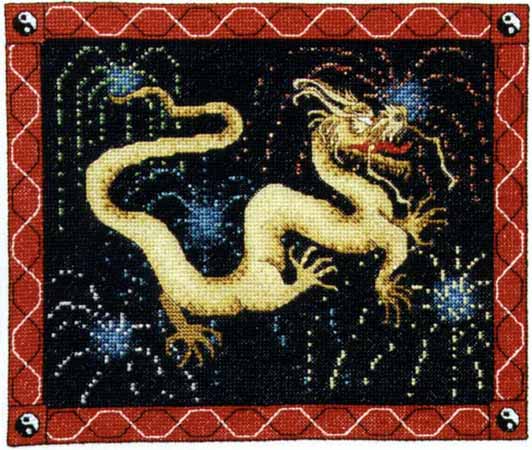
The symbol of the dragon represents spiraling DNA, the path to greater enlightenment.
As the emblem of the Emperor and the Imperial command, the legend of the Chinese Dragon permeates the ancient Chinese civilization and shaped their culture until today. Its benevolence signifies greatness, goodness and blessings.
The Chinese Dragon, or Lung , symbolizes power and excellence, valiancy and boldness, heroism and perseverance, nobility and divinity. A dragon overcomes obstacles until success is his. He is energetic, decisive, optimistic, intelligent and ambitious.
Unlike the negative energies associated with Western Dragons, most Eastern Dragons are beautiful, friendly, and wise. They are the angels of the Orient. Instead of being hated, they are loved and worshipped. Temples and shrines have been built to honor them, for they control the rain, rivers, lakes, and seas. Many Chinese cities have pagodas where people used to burn incense and pray to dragons.
The Black Dragon Pool Chapel, near Peking, was reserved for the Empress and her court.
Special worship services took place there on the first and fifteenth of every month. Dragon shrines and altars can still be seen in many parts of the Far East. They are usually along seashores and riverbanks, because most Eastern Dragons live in water.
The Isle of the Temple, in Japan's Inland Sea, has become a famous stopover for pilgrims who meditate and pray to dragons. Both male and female dragons have mated with humans.
Their descendants became great rulers. The Japanese Emperor Hirohito traced his ancestry back 125 generations to Princess Fruitful Jewel, daughter of a Dragon King of the Sea.
Emperors in many Asian countries claimed to have dragon ancestors. This made them so proud, that everything they used was decorated with dragons and described in terms of the dragon: dragon-throne, dragon-robe, dragon-bed, dragon-boat. Calling an emperor "dragon-face" was a supreme compliment. People believed that rulers could change themselves into dragons. For hundreds of years, Japanese emperors sat concealed behind bamboo curtains whenever visitors came. Anyone who dared to peek was condemned to death.
Everything connected with Eastern Dragons is blessed.
The Year of the Dragon, which takes place ever twelve years, is lucky. Present-day Oriental astrologers claim that children born during Dragon Years enjoy health, wealth, and long life.
Dragons are so wise that they have been royal advisors. A thirteenth-century Cambodian king spent his nights in a golden tower, where he consulted with the real ruler of the land a nine-headed dragon.
Eastern Dragons are vain, even though they are wise. They are insulted when a ruler doesn't follow their advice, or when people do not honor their importance. Then, by thrashing about, dragons either stop making rain and cause water shortages, or they breathe black clouds that bring storms and floods. Small dragons do minor mischief, such as making roofs leak, or causing rice to be sticky. People set off firecrackers and carry immense paper dragons in special parades. They also race dragon-shaped boats in water all to please and appease their dragons.
The Dragon brings upon the essence of life, in the form of its celestial breath, known to many as sheng chi. He yields life and bestows its power in the form of the seasons, bringing water from rain, warmth from the sunshine, wind from the seas and soil from the Earth.
The Dragon is the ultimate representation of the forces of Mother Nature, the greatest divine force on Earth.
The Chinese Dragon is often seen as the symbol of divine protection and vigilance. It is regarded as the Supreme Being amongst all creatures. It has the ability to live in the seas, fly up the heavens and coiled up in the land in the form of mountains. Being the divine mythical animal, the Dragon can ward off wandering evil spirits, protect the innocent and bestow safety to all that hold his emblem. The Chinese Dragon is look upon as the ultimate symbol of Good Fortune.
Year of the Dragon - Personality Traits
Occupying the 5th position in the Chinese Zodiac, the Dragon is the mightiest of the signs. Dragons symbolize such character traits as dominance and ambition. Dragons prefer to live by their own rules and if left on their own, are usually successful. TheyÕre driven, unafraid of challenges, and willing to take risks. They are passionate in all they do and they do things in grand fashion. Unfortunately, this passion and enthusiasm can leave Dragons feeling exhausted and interestingly, unfulfilled.
While Dragons frequently help others, rarely will they ask for help. Others are attracted to Dragons, especially their colorful personalities, but deep down, Dragons prefer to be alone. Perhaps that is because theyÕre most successful when working alone. Their preference to be alone can come across as arrogance or conceitedness, but these qualities arenÕt applicable. Dragons have tempers that can flare fast.
Health
Considering their hard-working nature, Dragons are healthy overall. They do get stressed and suffer from periodic tension/headaches, likely because they take so many risks. Dragons could benefit from incorporating mild activity into their lives. Yoga or walking would be good as these activities can work both their minds and their bodies.
Career
Dragons prefer leading to being led. Jobs that allow them to express their creativity are good choices. Some good careers include: inventor, manager, computer analyst, lawyer, engineer, architect, broker, and sales person.
Relationships
Dragons will give into love, but wonÕt give up their independence. Because they have quick, sometimes vengeful tempers, their partners need to be tough-skinned. Dragons enjoy others who are intriguing, and when they find the right partners, theyÕll usually commit to that person for life.
Dragons and the 5 Elements
Water Dragons - Years 1952 and 2012
The Water Dragon is less selfish and opinionated than the other Dragons. He is more inhibited and less power-hungry. He can accept defeat without recriminations. He makes a good negotiator as he knows when, where, and how to apply pressure. He has a tendency to be over-optimistic and needs to learn how to relinquish what is unfeasible so that he can concentrate his energies on the most rewarding endeavors.
Wood Dragons - Years 1904 and 1964
Fire Dragons - Years 1916 and 1976
The Fire Dragon is the most extroverted and competitive Dragon. He tends to push too hard and expects a lot from everyone. His criticisms are objective and he has the ability to arouse massive popular support. His insatiable ambition can make him short-tempered and intolerant. He is an empire builder who needs to master his less favorable traits and learn how to communicate more humbly with people as individuals.
Earth Dragons - Years 1928 and 1988
The Earth Dragon is a quieter, more reflective Dragon, He will be appreciative of other's opinions even if he fails to agree with them. He is reasonable in his approach to problems and his leadership is less dictatorial. He is not given to outbursts of temper, but at the same time demands respect. He knows the value of cooperation and is more diplomatic than the other Dragons. He is ambitious, but his initiatives are less hurried and more carefully thought out.
Metal Dragons - Years 1940 and 2000
The Metal Dragon is the most strong-willed Dragon. He is inflexible, unbending and combative. He gives little regard to the feelings of others. This ruthlessness can result in a rapid rise to a position of authority, but often at the cost of destroying important relationships. It is futile to attempt to convince him that certain things are simply undoable. He will go it alone if he can't gain support. He succeeds because he refuses to accept failure.
Types of Dragons
The last of the nine is the dragon king, which actually consists of four separate dragons, each of which rules over one of the four seas, those of the east, south, west, and north.
The most powerful generalized type of Chinese dragon is the horned dragon, or lung, which can produce rain and is totally deaf. Additionally, there is a homeless dragon (Ii) that lives in the ocean and another type (chiao) that is scale-covered and usually inhabits marshes but also keeps dens in the mountains.
There are also nine ways the Chinese have traditionally represented these dragons, each one revealing a different dragon characteristic. There are dragons carved on the tops of bells and gongs, because of the beast's habit of calling loudly when attacked.
A second type is carved on the screws of fiddles, since most dragons are fond of music.
A third is carved on the tops of stone tablets, because of dragons' love of literature.
A fourth is found at the bottom of stone monuments, as dragons can support heavy weights.
A fifth is placed on the eaves of temples, as dragons are ever alert to danger.
A sixth occurs on the beams of bridges, since dragons are fond of water.
A seventh is carved on Buddha's throne, as dragons like to rest.
An eighth is placed on the hilts of swords, since dragons are known to be capable of slaughter.
The ninth is carved on prison gates, as these are dragons that are fond of quarreling and trouble making.
The colors of Chinese dragons are evidently quite variable, but in the case of the chiao type its back is striped with green, its sides are yellow, and it is crimson underneath.
The nine major characteristics of a lung type dragon include a head like a camel's, horns like a deer's, eyes like a hare's, ears like a bull's, a neck like an iguana's, a belly like a frog's, scales like a carp's, paws like a tiger's, and claws like an eagle's. It has a pair of large canine teeth in its upper jaw. The long, tendril-like whiskers extending from either side of its mouth are probably used for feeling its way along the bottom of muddy ponds.
In color dragons varies from greenish to golden, with a series of alternating short and long spines extending down the back and along the tail, where they become longer. One specimen had wings at its side, and walked on top of the water. Another tossed its mane back and forth making noises that sounded like a flute.
Cow-heads are also common. A ten-footer, found lying on the banks of China's Yangtze River, was different from most because of its long, thick eyebrows. A Yellow River variety, seen on shore in the 1920s by a Chinese teacher, was bright blue, and as big as five cows. Both dragons crawled into the water as soon as it started to rain.
A few dragons begin life as fish. Carp, who successfully jump rapids and leap over waterfalls, change into fish-dragons. A popular saying, "The carp has leaped through the dragon's gate," means success, especially for students who have passed their exams.
Male dragons sometimes mate with other species of animal. A dragon fathers an elephant when he mates with a pig, and he sires a racehorse, after mating with a mare.
The 4 Dragons: A Chinese Tale
One day the four dragons flew from the sea into the sky. They soared and dived, playing at hide-and-seek in the clouds.
"Come over here quickly!" the Pearl Dragon cried out suddenly.
"What's up?" asked the other three, looking down in the direction where the Pearl Dragon pointed. On the earth they saw many people putting out fruits and cakes, and burning incense sticks. They were praying! A white-haired woman, kneeling on the ground with a thin boy on her back, murmured:
"Please send rain quickly, God of Heaven, to give our children rice to eat.."
For there had been no rain for a long time. The crops withered, the grass turned yellow and fields cracked under the scorching sun.
"How poor the people are!" said the Yellow Dragon. "And they will die if it doesn't rain soon."
The Long Dragon nodded. Then he suggested, "Let's go and beg the Jade Emperor for rain."
So saying, he leapt into the clouds. The others followed closely and flew towards the Heavenly Palace.
Being in charge of all the affairs in heaven, on earth and in the sea, the Jade Emperor was very powerful. He was not pleased to see the dragons rushing in. "Why do you come here instead of staying in the sea and behaving yourselves?"
The Long Dragon stepped forward and said, "The crops on earth are withering and dying, Your Majesty. I beg you to send rain down quickly!"
"All right. You go back first, I'll send some rain down tomorrow." The Jade Emperor pretended to agree while listening to the songs of the fairies.
"Thanks, Your Majesty!" The four dragons went happily back.
But ten days passed, and not a drop of rain came down.
The people suffered more, some eating bark, some grass roots, some forced to eat white clay when they ran out of bark and grass roots.
Seeing all this, the four dragons felt very sorry, for they knew the Jade Emperor only cared about pleasure, and never took the people to heart. They could only rely on themselves to relieve the people of their miseries. But how to do it?
Seeing the vast sea, the Long Dragon said that he had an idea.
"What is it? Out with it, quickly!" the other three demanded.
"Look, is there not plenty of water in the sea where we live? We should scoop it up and spray it towards the sky. The water will be like rain drops and come down to save the people and their crops."
"Good idea!" The others clapped their hands.
"But," said the Long Dragon after thinking a bit, "We will be blamed if the Jade Emperor learns of this.
"I will do anything to save the people," the Yellow Dragon said resolutely.
"Let's begin. We will never regret it." The Black Dragon and the Pearl Dragon were not to be outdone.
They flew to the sea, scooped up water in their mouths, and then flew back into the sky, where they sprayed the water out over the earth. The four dragons flew back and forth, making the sky dark all around. Before long the seawater became rain pouring down from the sky.
"It's raining! It's raining!"
"The crops will be saved!"
The people cried and leaped with joy. On the ground the wheat stalks raised their heads and the sorghum stalks straightened up.
The god of the sea discovered these events and reported to the Jade Emperor.
"How dare the four dragons bring rain without my permission!" The Jade Emperor was enraged, and ordered the heavenly generals and their troops to arrest the four dragons. Being far outnumbered, the four dragons could not defend themselves, and they were soon arrested and brought back to the heavenly palace.
"Go and get four mountains to lay upon them so that they can never escape!" The Jade Emperor ordered the Mountain God.
The Mountain God used his magic power to make four mountains fly there, whistling in the wind from afar, and pressed them down upon the four dragons.
Imprisoned as they were, they never regretted their actions. Determined to do good for the people forever, they turned themselves into four rivers, which flowed past high mountains and deep valleys, crossing the land from the west to the east and finally emptying into the sea. And so China's four great rivers were formed -- the Heilongjian (Black Dragon) in the far north, the Huanghe (Yellow River) in central China, the Changjiang (Yangtze, or Long River) farther south, and the Zhujiang (Pearl) in the very far south.
Symbols of Rain and Water
Chinese dragons are believed to be the rulers of moving bodies of water, such as waterfalls, rivers, or seas. They can show themselves as water spouts (tornado or twister over water). There are four major dragons, one representing each sea. For instance the Dragon King of the Eastern Sea, Dragon King of the Western Sea, and so forth.
Because of this association, they are seen as "in charge" of water-related weather phenomenon. In premodern times, many Chinese villages (especially those living close to rivers) had temples dedicated to their local "dragon king." In times of drought or flooding, it was customary for the local gentry and government officials to lead the community in offering sacrifices and conducting other religious rites to appease the dragon, either to ask for rain or a cessation thereof.
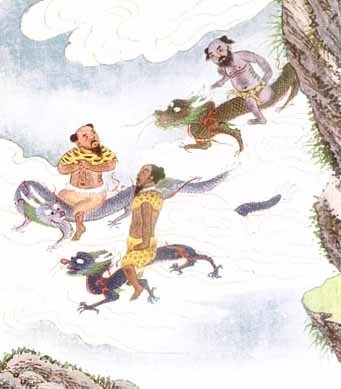 Dragon Gods align with Ancient Alien Theory
Dragon Gods align with Ancient Alien Theory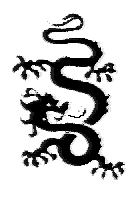
Dragons

Dragonflies
Dragon Influences
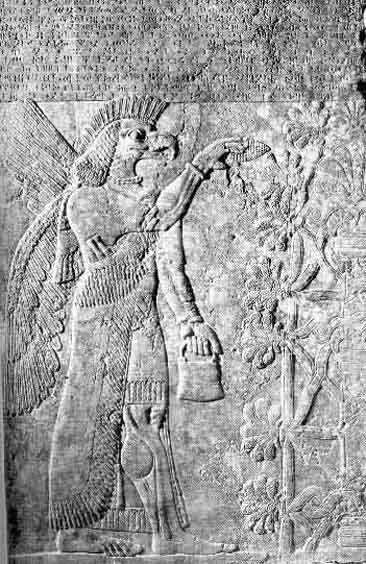
Gods Create Bloodlines - Hybrids and Biogenetic Experiments
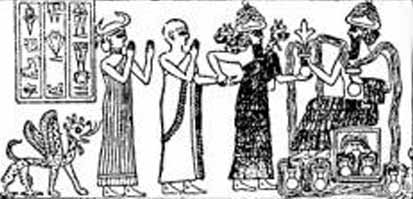
Sumerian Gods Allegedly Create a Biogenetic Experiment
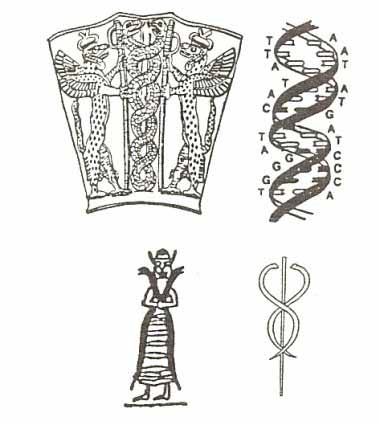
Caduceus Rod of Hermes, DNA
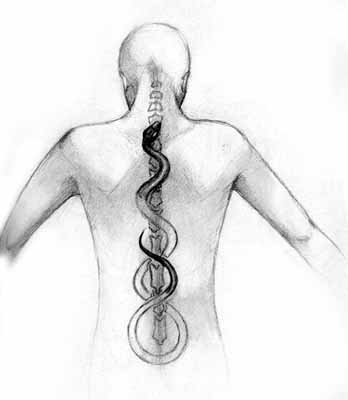
Kundalini
Release of Information from the 8 Origin Cells at the Base of the Spine
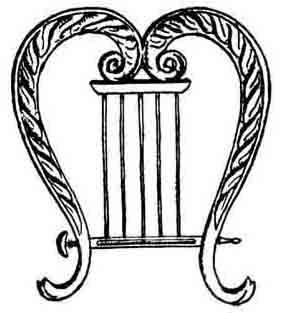
Lyra of Hermes
Using the Rod to Slay the Dragon
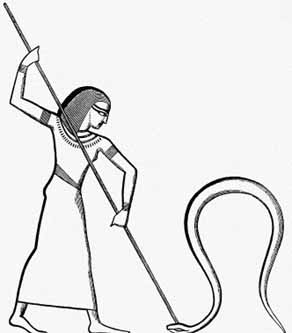
Omega Project, Ending the human DNA, Experiment - Leo, Lion
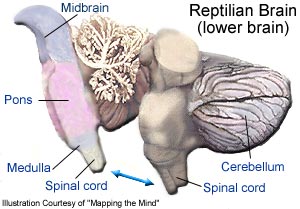
Reptilian Part of the Brain

Spiraling DNA, Golden Ratio, Fibonacci Numbers, Consciousness
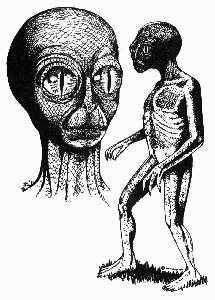
Reptilians
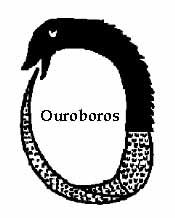
Ouroboros
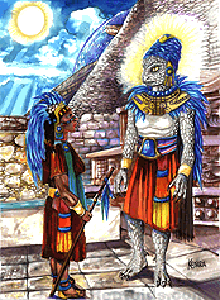
Quetzalcoatl Feather Serpent God, 2012, Mayan Calendar
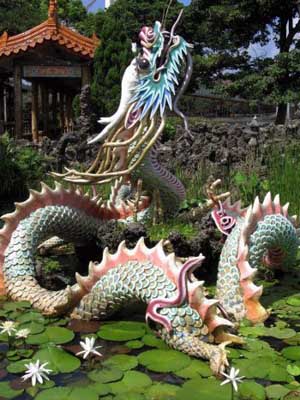
The Mystery of the Dragon
Epoch Times - March 2, 2010
Chinese Clock
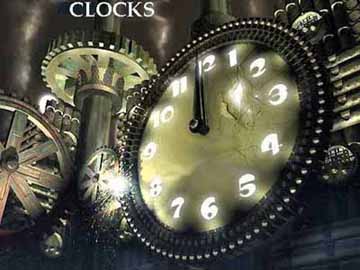
Pre-historic man did not have a need for clocks, but as civilization evolved, that all changed. The historical record reveals that approximately 5000 to 6000 years ago great civilizations in the Middle East and North Africa began to make clocks to augment their calendars. With their attendant bureaucracies, formal religions, and other burgeoning societal activities, these cultures apparently found a need to organize their time more efficiently.
A clock is an instrument for measuring time and for measuring time intervals of less than a day - as opposed to a calendar. Those used for technical purposes, of very high accuracy, are usually called chronometers. A portable clock is called a watch. The clock in its most common modern form (in use since at least the 14th century) displays the hours, minutes and, sometimes, seconds that pass during a twelve- or twenty-four-hour period.
One of the key drivers of inventing methods of keeping track of time were the farmers needs to determine the best time to plant. Archaeologists have discovered bones with inscriptions that are believed to have been used to track lunar cycles.
The clock is one of the oldest human inventions, requiring a physical process that will proceed at a known rate and a way to gauge how long that process has run. As the seasons and the phases of the moon can be used to measure the passage of longer periods of time, shorter processes had to be used to measure off hours and minutes.
Hourglass
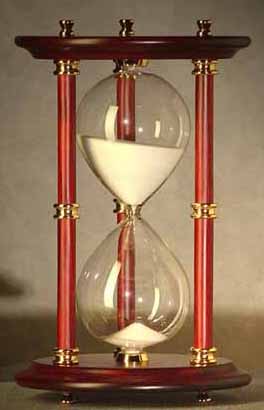
An hourglass filled with fine sand, poured through a tiny hole,at a constant rate, indicated a predetermined passage of time. An hour glass is basically 2 bubbles of glass with a narrow middle; wood is used to close off the sand. The sand is measured and sealed and the hour glass is turned over and over. This type of clock was the first one to not be dependent on the weather. It's used for short periods of time such as speeches, sermons, watch duty, cooking, and at sea to calculate one's position.
To calculate the speed at sea, one would throw a piece of wood overboard tied with a knotted rope. When a knot ran through one's fingers in 1/2 a minute measured by the hour glass, it indicated that the vessel was going at the speed of 1 nautical mile an hour. The knots were very wide apart and one just counted the knots. Hence the phrase "knots an hour". The center of the hour glass would get clogged. Course sand wore away at the center and made the opening wider. An hour glass had to be on a flat surface in order to work properly.
Sundial

A sundial is a device that measures time by the position of the Sun. In common designs such as the horizontal sundial, the sun casts a shadow from its style (a thin rod or a sharp, straight edge) onto a flat surface marked with lines indicating the hours of the day. As the sun moves across the sky, the shadow-edge progressively aligns with different hour-lines on the plate. Such designs rely on the style being aligned with the axis of the Earth's rotation. Hence, if such a sundial is to tell the correct time, the style must point towards true north (not the north or south magnetic pole) and the style's angle with horizontal must equal the sundial's geographical latitude.
Sundials can be categorized in several ways: first, some sundials use a line of light to indicate the time, where others use the edge of a shadow. In the former case, the spot of light may be formed by allowing the sun's rays through a small hole or reflecting them from a small circular mirror; a line of light may be formed by allowing the rays through a thin slit or focusing them through a cylindrical lens. In the other case, the shadow-casting object - the sundial's gnomon - may be a thin rod, or any object with a sharp tip or a straight edge.
Second, sundials employ many types of gnomon. The gnomon may be fixed or moved according to the season; it may be oriented vertically, horizontally, aligned with the Earth's axis, or oriented in an altogether different direction determined by mathematics.
Third, sundials may use many types of surfaces to receive the spot or line of light, the shadow-tip or shadow-edge. Planes are the most common surface, but partial spheres, cylinders, cones and even more complicated shapes have been used for greater accuracy or intriguing aesthetics.
Fourth, sundials differ in their portability and their need of orientation. The installation of many dials requires knowing the local latitude, the precise vertical direction (e.g., by a level or plumb-bob), and the direction to true North. In contrast, other dials are self-aligning; for example, two dials that operate on different principles, such as a horizontal and analemmatic dial, may be mounted together on one plate, such that their times agree only when the plate is aligned properly.
Sundials indicate the local solar time, unless otherwise corrected. To obtain the standard clock time, three types of corrections need to be made. First, the solar time needs to be corrected for the longitude of the sundial relative to the longitude at which the official time zone is defined.
For example, a sundial located west of Greenwich, England but within the same time-zone, shows a later time than the official time; it will show "noon" after the official noon has passed, since the sun passes overhead later, since the sundial is further in the west. This correction is often made by rotating the hour-lines by an angle equaling the difference in longitudes.
Second, the practice of daylight saving time shifts the official time away from solar time by an hour or, in rare cases, by another amount. This correction is usually made by numbering the hour-lines with two sets of numbers. Third, the orbit of the Earth is not perfectly circular and its rotational axis not perfectly perpendicular to its orbit, which together produce small variations in the sundial time throughout the year. This correction - which may be as great as 15 minutes is described by the equation of time.
A more sophisticated sundial design is required to incorporate this correction automatically; alternatively, a small plaque can be affixed to the sundial giving the offsets at various times of the year. The marker of the sundial, the gnomon is set parallel to the Earth's axis and pointing at the celestial pole.Its angle therefore depends on the latitude. The shadow of the gnomon falls on a dial, allowing the time to be read off.
The principles of sundials can be understood most easily from an ancient model of the Sun's motion. Science has established that the Earth rotates on its axis, and revolves in an elliptic orbit about the Sun; however, meticulous astronomical observations and physics experiments were required to establish this.
For navigational and sundial purposes, it is an excellent approximation to assume that the Sun revolves around a stationary Earth on the celestial sphere, which rotates every 23 hours and 56 minutes about its celestial axis, the line connecting the celestial poles.
Since the celestial axis is aligned with the axis about which the Earth rotates, its angle with the local horizontal equals the local geographical latitude. Unlike the fixed stars, the Sun changes its position on the celestial sphere, being at positive declination in summer, at negative declination in winter, and having exactly zero declination (i.e., being on the celestial equator) at the equinoxes. The path of the Sun on the celestial sphere is known as the ecliptic, which passes through the twelve constellations of the zodiac in the course of a year.
This model of the Sun's motion helps to understand the principles of sundials. If the shadow-casting gnomon is aligned with the celestial poles, its shadow will revolve at a constant rate, and this rotation will not change with the seasons. This is perhaps the most commonly seen design and, in such cases, the same set of hour lines may be used throughout the year. The hour-lines will be spaced uniformly if the surface receiving the shadow is either perpendicular (as in the equatorial sundial) or circularly symmetric about the gnomon (as in the armillary sphere).
In other cases, the hour-lines are not spaced evenly, even though the shadow is rotating uniformly. If the gnomon is not aligned with the celestial poles, even its shadow will not rotate uniformly, and the hour lines must be corrected accordingly. The rays of light that graze the tip of a gnomon, or which pass through a small hole, or which reflect from a small mirror, trace out a cone that is aligned with the celestial poles.
The corresponding light-spot or shadow-tip, if it falls onto a flat surface, will trace out a conic section, such as a hyperbola, ellipse or (at the North or South Poles) a circle. This conic section is the intersection of the cone of light rays with the flat surface. This cone and its conic section change with the seasons, as the Sun's declination changes; hence, sundials that follow the motion of such light-spots or shadow-tips often have different hour-lines for different times of the year, as seen in shepherd's dials, sundial rings, and vertical gnomons such as obelisks.
Alternatively, sundials may change the angle and/or position of the gnomon relative to the hour lines, as in the analemmatic dial or the Lambert dial.
Clocks in Ancient Civilizations
Incense Alarm Clock
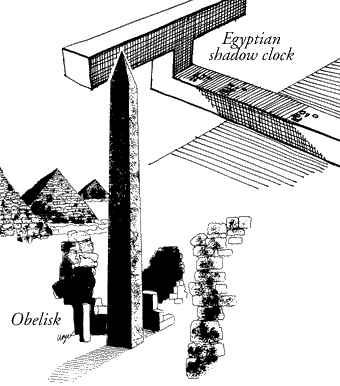
The Egyptians, by 2100 BC, had invented a means to divide the day into 24 hours using sundials or shadow clocks to measure the time of day. The Sundial indicates the time of day by the positioning of the shadow of some object on which the sun's rays fall. The shadow clock consists of a straight base with a raised crosspiece at one end. A scale with time divisions is inscribed on the base. The clock is set east-west and is reversed at midday.
The Egyptians also divided the day into 12 parts as well. They used huge granite columns called Cleopatra Needles, a trio of obelisks, to keep track of time periods. They had 12 marks on the ground that equalled 12 parts of the day. When the sun touched the top, a shadow was created and the length and position of the shadow told the Egyptians how much daylight remained. They invented a portable piece called a sundial. It contains 3 parts: a circular dial, a needle and a style (gnomon) to keep the needle in place. Cleopatra's needles were inconvient and impractical for the average person.
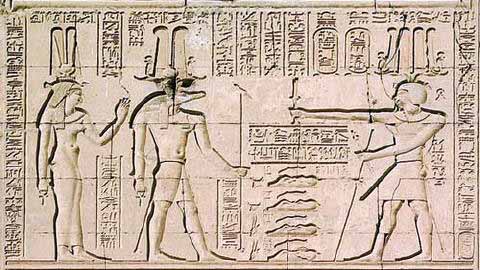
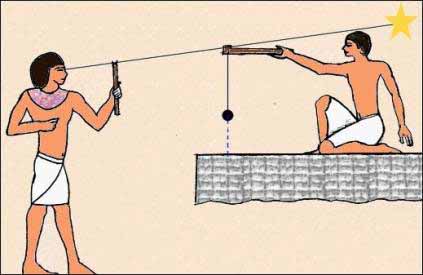
The 'merkhet', the oldest known astronomical tool, was an Egyptian development of around 600ÊB.C. A pair of merkhets were used to establish a north-south line by lining them up with the Pole Star. They could then be used to mark off nighttime hours by determining when certain other stars crossed the meridian. The Merkhet, known as the "instrument of knowing" was a sighting tool made from the central rib of a palm leaf and was similar in function to an astrolobe. The merkhet was used for aligning the foundations of the pyramids and sun temples with the cardinal points, and was usually correct to within less than half a degree.
In the quest for more year-round accuracy, sundials evolved from flat horizontal or vertical plates to more elaborate forms. One version was the hemispherical dial, a bowl-shaped depression cut into a block of stone, carrying a central vertical gnomon and scribed with sets of hour lines for different seasons. The hemicycle, said to have been invented about 300ÊB.C., removed the useless half of the hemisphere to give an appearance of a half-bowl cut into the edge of a squared block. By 30ÊB.C., Vitruvius could describe 13 different sundial styles in use in Greece, Asia Minor, and Italy.
Water Clock
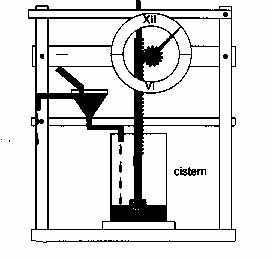
One of the oldest water clocks was found in the tomb of Amenhotep I, buried around 1500 B.C.
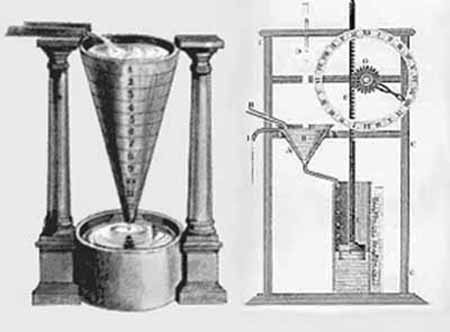
Later they were named clepsydras ('water thief') by the Greeks, who began using them about 325 B.C. These were stone vessels with sloping sides that allowed water to drip at a nearly constant rate from a small hole near the bottom.
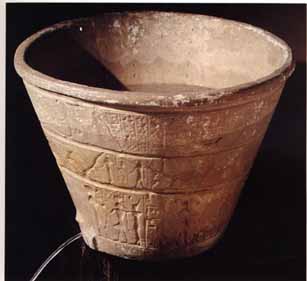
Other Egyptian clepsydras were cylindrical or bowl-shaped containers designed to slowly fill with water coming in at a constant rate. Markings on the inside surfaces measured the passage of "hours" as the water level reached them. These clocks were used to determine hours at night, but may have been used in daylight as well. Another version consisted of a metal bowl with a hole in the bottom; when placed in a container of water the bowl would fill and sink in a certain time. These were still in use in North Africa this century. The need to track night hours lead to the invention of the water clock by 1500 BC, the Egyptians. This clock uses the steady dripping of water from a vessel to drive a mechanical device that tells the time. It was basically a bucket of water with a hole in the bottom. A water clock showed the passage of time but it didn't keep exact hours in a day. Egyptians were the people most likely to have invented them but the Greeks had the most advanced ones.
The historian Vitruvius reported that the ancient Egyptians used a clepsydra, a time mechanism using flowing water. Herodotus had mentioned an ancient Egyptian time-keeping device that was based on mercury. By the 9th century AD a mechanical timekeeper had been developed that lacked only an escapement mechanism.
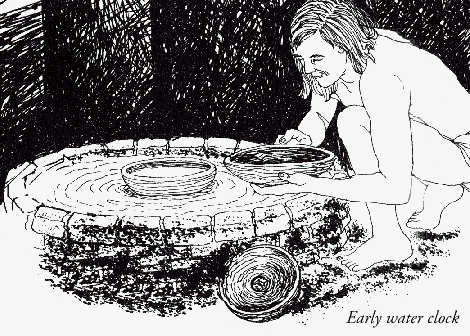
In 250 B.C, Archimedes built a more elaborate water clock; he added gears and showed the planets and moon orbiting.
In order for a water clock to work properly, someone had to keep an eye on it; to make sure that no pebbles were in the bowl to increase talking time. These clocks were never exact; each clock had its own pace. And they couldn't be used in winter.
These clocks were used for nearly 3,000 years and grew more and more sophisticated. Water clocks were designed with ringing bells, moving puppets and mechanical singing birds.
More elaborate and impressive mechanized water clocks were developed between 100 B.C. and 500 A.D. by Greek and Roman horologists and astronomers. The added complexity was aimed at making the flow more constant by regulating the pressure, and at providing fancier displays of the passage of time. Some water clocks rang bells and gongs, others opened doors and windows to show little figures of people, or moved pointers, dials, and astrological models of the universe.
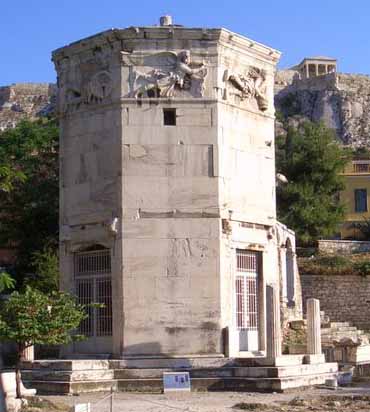
Greek astronomer, Andronikos, supervised the construction of the Tower of the Winds in Athens in the 1st century B.C. This octagonal structure showed scholars and marketplace shoppers both sundials and mechanical hour indicators. It featured a 24-hour mechanized clepsydra and indicators for the eight winds from which the tower got its name, and it displayed the seasons of the year and astrological dates and periods. The Romans also developed mechanized clepsydras, though their complexity accomplished little improvement over simpler methods for determining the passage of time.
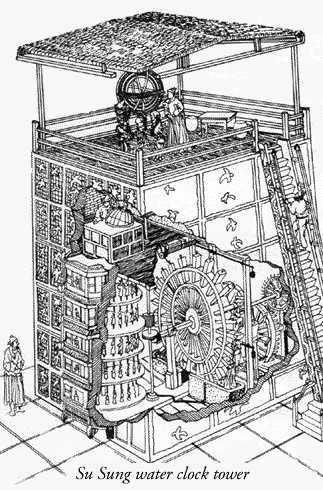
In the Far East, mechanized astronomical/astrological clock-making developed from 200 to 1300 A.D. Third-century Chinese clepsydras drove various mechanisms that illustrated astronomical phenomena. One of the most elaborate clock towers was built by Su Sung and his associates in 1088 A.D. Su Sung's mechanism incorporated a water-driven escapement invented about 725 A.D. The Su Sung clock tower, over 30 feet tall, possessed a bronze power-driven armillary sphere for observations, an automatically rotating celestial globe, and five front panels with doors that permitted the viewing of changing mannikins which rang bells or gongs, and held tablets indicating the hour or other special times of the day.
Early Mechanical Clocks
14th century clocks show the four key elements common to all clocks in subsequent centuries, at least up to the digital age:
- the power, supplied by a falling weight, later by a coiled spring
- the escapement, a periodic repetitive action that allows the power to escape in small bursts rather than drain away all at once
- the going train, a set of interlocking gear wheels that controls the speed of rotation of the wheels connected between the power supply and the indicators
- indicators, such as dials, hands, and bells
The word 'horologia' (from the Greek hora, hour, and legein, to tell) was used to describe all these devices but the use of this word (still used in several romance languages) for all timekeepers conceals from us the true nature of the mechanisms. For example, there is a record that in 1176 Sens Cathedral installed a 'horologe' but the mechanism used is unknown.
In 1198, during a fire at the abbey of St Edmundsbury (now Bury St Edmunds) the monks 'ran to the clock' to fetch water, indicating that their water clock had a reservoir large enough to help extinguish the occasional fire.These early clocks may not have used hands or dials but ÒtoldÓ the time with audible signals.
The word 'clock' (from the Latin word for "bell") which gradually supersedes 'horologe' suggests that it was the sound of bells which also characterized the prototype mechanical clocks that appeared during the 13th century.
Between 1280 and 1320 there is an increase in the number of references to clocks and horologes in church records, and this probably indicates that a new type of clock mechanism had been devised. Existing clock mechanisms that used water power were being adapted to take the driving power from falling weights. This power was controlled by some form of oscillating mechanism, probably derived from existing bell-ringing or alarm devices. This controlled release of power - the escapement - marks the beginning of the true mechanical clock.
These mechanical clocks were intended for two main purposes: for signaling and notification (e.g. the timing of services and public events), and for modeling the solar system. The former purpose is administrative, the latter arises naturally given the scholarly interest in astronomy, science, astrology, and how these subjects integrated with the religious philosophy of the time.
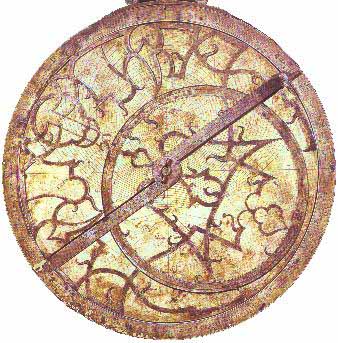
Simple clocks intended mainly for notification were installed in towers, and did not always require dials or hands. They would have announced the canonical hours or intervals between set times of prayer. Canonical hours varied in length as the times of sunrise and sunset shifted.
The more sophisticated astronomical clocks would have had moving dials or hands, and would have shown the time in various time systems, including Italian hours, canonical hours, and time as measured by astronomers at the time. Both styles of clock started acquiring extravagant features such as automata.
In 1283 a large clock was installed at Dunstable Priory; its location above the rood screen suggests that it was not a water clock.
In 1292, Canterbury Cathedral installed a 'great horloge'. Over the next 30 years there are brief mentions of clocks at a number of ecclesiastical institutions in England, Italy, and France.
In 1322 a new clock was installed in Norwich, an expensive replacement for an earlier clock installed in 1273. This had a large (2 metre) astronomical dial with automata and bells. The costs of the installation included the full-time employment of two technicians for two years.
The first major advance in clock construction occurred in Europe during the 14th century. It was found that the speed of a falling weight could be controlled by using a oscillating horizontal bar attached to a vertical spindle with two protrusions on it which acted like escapements, (cliff like ridges). When the protrusions meshed with a tooth of a gear driven by the weight, it momentarily stopped the revolving wheel and weight. These oldest type of mechanical clocks can still be seen in France and England.
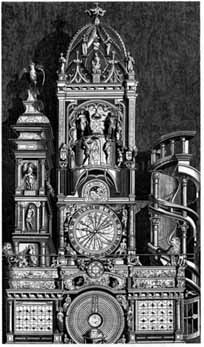
Strasbourg Cathedral
View my trip there in 2005
As Europe grew, each town had to find a way to tell time; there was an emphasis on productivity and work.
14th Century
15th Century
Spring-driven clocks were developed during the 15th century, and
this gave the clockmakers many new problems to solve, such as how to
compensate for the changing power supplied as the spring unwound.
The first record of a minute hand on a clock is 1475, in the Almanus Manuscript of Brother Paul.
16th Century
Replacing the heavy drive weights permitted smaller (and portable) clocks and watches.
Although they slowed down as the mainspring unwound, they were popular among wealthy individuals due to their size and the fact that they could be put on a shelf or table instead of hanging from the wall. These advances in design were precursors to truly accurate timekeeping.
In 1577 the minute hand was invented by Jost Burgi for Tycho Brahe; he was an astronomer who needed accurate clocks to track stars.
During the 15th and 16th centuries, clockmaking flourished, particularly in the metalworking towns of Nuremberg and Augsburg, and, in France, Blois. Some of the more basic table clocks have only one time-keeping hand, with the dial between the hour markers being divided into four equal parts making the clocks readable to the nearest 15 minutes. Other clocks were exhibitions of craftsmanship and skill, incorporating astronomical indicators and musical movements.
The cross-beat escapement was developed in 1585 by Jobst Burgi, who also developed the remontoire. Burgi's accurate clocks helped Tycho Brahe and Johannes Kepler to observe astronomical events with much greater precision than before.The first record of a second hand on a clock is about 1560, on a clock now in the Fremersdorf collection.
However, this clock could not have been accurate, and the second hand was probably for indicating that the clock was working.The next development in accuracy occurred after 1657 with the invention of the pendulum clock.
17th Century
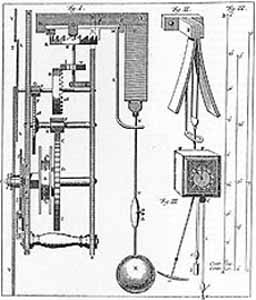
Christiaan Huygens' pendulum clock was regulated by a mechanism with a "natural" period of oscillation. Huygens' pendulum clock had an error of less than 1 minute a day, the first time such accuracy had been achieved. His later refinements reduced his clock's errors to less than 10 seconds a day.
Around 1675 Huygens developed the balance wheel and spring assembly, still found in some of today's wrist watches. This improvement allowed 17th century watches to keep time to 10 minutes a day. And in London in 1671 William Clement began building clocks with the new "anchor" or "recoil" escapement, a substantial improvement over the verge because it interferes less with the motion of the pendulum.
In 1670, the English clockmaker William Clement created the anchor escapement, an improvement over Huygens' crown escapement. Within just one generation, minute hands and then second hands were added.
A major stimulus to improving the accuracy and reliability of clocks was the importance of precise time-keeping for navigation. The position of a ship at sea could be determined with reasonable accuracy if a navigator could refer to a clock that lost or gained less than about 10 seconds per day. Many European governments offered a large prize for anyone that could determine longitude accurately.
Christiaan Huygens, however, is usually credited as the inventor. He determined the mathematical formula that related pendulum length to time (99.38 cm or 39.13 inches for the one second movement) and had the first pendulum-driven clock made.
The pendulums swinging ensures that the protrusions move the gears wheels tooth by tooth while the motion of the protrusions keeps the pendulum moving. It was improved further by the Englishmen Robert Hooke who invented the anchor or recoil escapement.
During the 16th and 17th centuries the need for accurate clocks while sailing across the oceans arose. While springs made clocks portable, they were not accurate for long periods. Hooke realized that a spring would not be affected by the ship's motion as a pendulum would, but the available mainspring devices were not accurate enough for long periods of time until 1675, when the balance wheel, a very thin spiral hairspring (separate from the mainspring) whose inner end was secured to the spindle of a rotatable balance and whose outer end was fixed to the case of the timepiece. The spring stored or released energy during the rotation of the balance. John Harrison's chronometer no. 4, was in error by only 54 seconds after a sea voyage of 156 days.
The balance wheel, hairspring, and mainspring, together with the anchor escapement, or improved escapements, still make up the basics of even todays modern watches. Introduction of jewels as bearings have further improved on this basic system.
This improved the functioning of the gear train. Infact, this method is still used today. The greatest benefit of this method was that it allowed for very long pendulums with a swing of one second. The out growth of this invention was the walled pendulum clock where the weights and pendulum are completely enclosed in a case. Of course, most people are very familiar with these clocks with the most common being the 'Grandfather Clock'.

The reward was eventually claimed in 1761 by John Harrison, who dedicated his life to improving the accuracy of his clocks. His H5 clock is reported to have lost less than 5 seconds over 10 days.
The excitement over the pendulum clock had attracted the attention of designers resulting in a proliferation of clock forms. Notably, the longcase clock (also known as the grandfather clock) was created to house the pendulum and works. The English clockmaker William Clement is also credited with developing this form in 1670 or 1671. It was also at this time that clock cases began to be made of wood and clock faces to utilize enamel as well as hand-painted ceramics.
18th Century
In 1721 George Graham improved the pendulum clock's accuracy to 1 second a day by compensating for changes in the pendulum's length due to temperature variations. John Harrison, a carpenter and self-taught clock-maker, refined Graham's temperature compensation techniques and added new methods of reducing friction.
By 1761 he had built a marine chronometer with a spring and balance wheel escapement that won the British government's 1714 prize (of over $2,000,000 in today's currency) offered for a means of determining longitude to within one-half degree after a voyage to the West Indies. It kept time on board a rolling ship to about one-fifth of a second a day, nearly as well as a pendulum clock could do on land, and 10 times better than required.
On November 17, 1797, Eli Terry received his first patent for a clock. Terry is known as the founder of the American clock-making industry.
19th Century
Alexander Bain, Scottish clockmaker, patented the electric clock in 1840. The electric clock's mainspring is wound either with an electric motor or with an electro-magnet and armature. In 1841, he first patented the electromagnetic pendulum.
Over the next century refinements led in 1889 to Siegmund Riefler's clock with a nearly free pendulum, which attained an accuracy of a hundredth of a second a day and became the standard in many astronomical observatories. A true free-pendulum principle was introduced by R. J. Rudd about 1898, stimulating development of several free-pendulum clocks.
20th Century
One of the most famous, the W. H. Shortt clock, was demonstrated in 1921. The Shortt clock almost immediately replaced Riefler's clock as a supreme timekeeper in many observatories.
This clock consists of two pendulums, one a slave and the other a master. The slave pendulum gives the master pendulum the gentle pushes needed to maintain its motion, and also drives the clock's hands. This allows the master pendulum to remain free from mechanical tasks that would disturb its regularity.
Watches run by small batteries were introduced in the 1950s. The balance of such an electric watch is kept in motion electromagnetically by a coil that is energized by an electronic circuit.
The development of electronics in the twentieth century led to clocks with no clockwork parts at all. Time in these cases is measured in several ways, such as by the vibration of a tuning fork, the behavior of quartz crystals, the decay of radioactive elements or resonance of polycarbonates. Even mechanical clocks have since come to be largely powered by batteries, removing the need for winding.
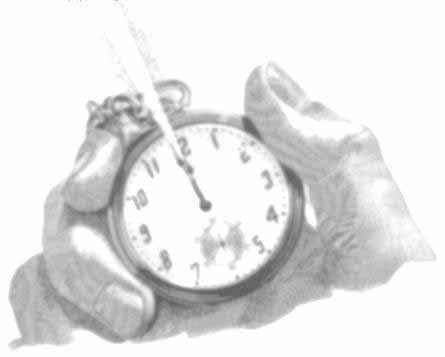
Clocks in the News ...
New 'fix' for cosmic clocks could help uncover ripples in space-time PhysOrg - June 25, 2010


'Quantum Logic Clock' Based on Aluminum Ion is Now World's Most Precise Clock PhysOrg - February 4, 2010
Doomsday Clock Changes Again Live Science - January 14, 2010
A clock more accurate than time itself New Scientist - February 9, 2009
Most Accurate Clock Ever: 'Crystal Of Light' Clock Science Daily - February 18, 2008
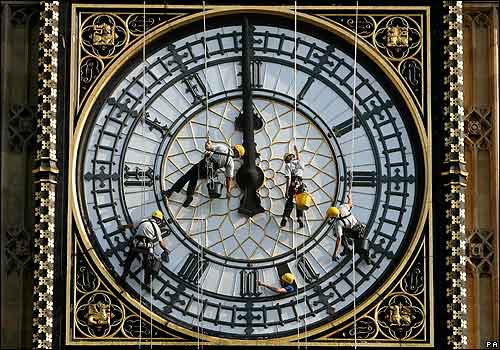
Big Ben silenced for repair work BBC - August 12, 2007
Climate resets 'Doomsday Clock' BBC - January 17, 2007
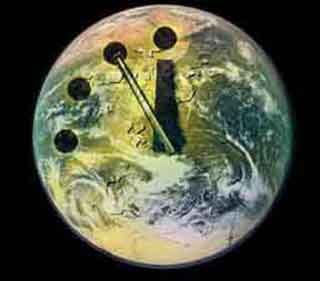
Doomsday Clock Wikipedia
Atomic Time Lords: Atomic ticker clocks up 50 years BBC - June 2, 2005
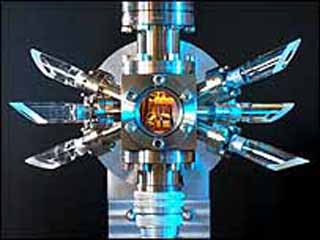
The most accurate clock of all time New Scientist - May 18, 2005
The clock that wakes you when you are ready New Scientist - April 2005
Discovery of an early historic clock dating to 6500 years
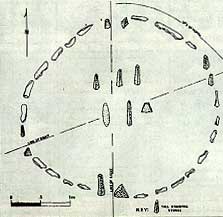
AP - April 10, 2001
- The joint archaeological mission of the University of Dallas
made huge discoveries in the area of Nabta 100 km west of Abu Simbel.
The discoveries relate to prehistoric times, tools, clay vessels, and
skeletons. The area of Nabta is one of the most important areas for
archaeological excavation related to prehistoric times. It measures
5,000 square meters and includes the remains of stores, wells and
houses. The mission also found tombs where in one of them there were 30
skeletons and some bracelets made of the teeth of animals and many clay
vessels.
-
Most important is what is thought to be the first clock. It is shaped as
a circle made of stones whose diameter is 4 meters. There are 6 stones
near the center and arranged in two lines extending east and west. Time
is measured by this clock through the shade of the stones in the center
which falls on the stones of the circle. Archaeologists found bulks of
stones placed in correspondence with the positions of the stars in order
to know the time of the different seasons especially the rainy ones.
They also found a tomb of a cow which indicates the beginning of
cow-worship identified later with the cow-goddess Hathor.
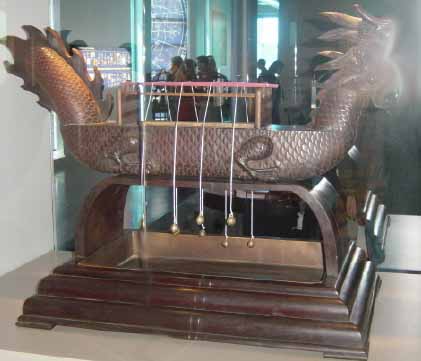
No comments:
Post a Comment